While we were in South Africa we were so fortunate to stay with our friends – Jim and Carrie – who live in Marloth Park (just outside of Kruger National Park) and experience their wonderful home, meet their friends at a Braai (South African BBQ), see the wildlife in their backyard and go on a walking safari with their friend and guide, Rick.
We’re breaking this post up a little differently to normal. I (Shae) will be sharing about our walking safari with Rick, then Stephen will take over and share about the animals and neighborhood of Marloth Park.
Rick is no longer offering freelance walking safaris in Marloth Park, but we were fortunate enough to take his last tour and learned so much. Here’s a tiny taste (quite literally in some cases) of what we experienced and learned.
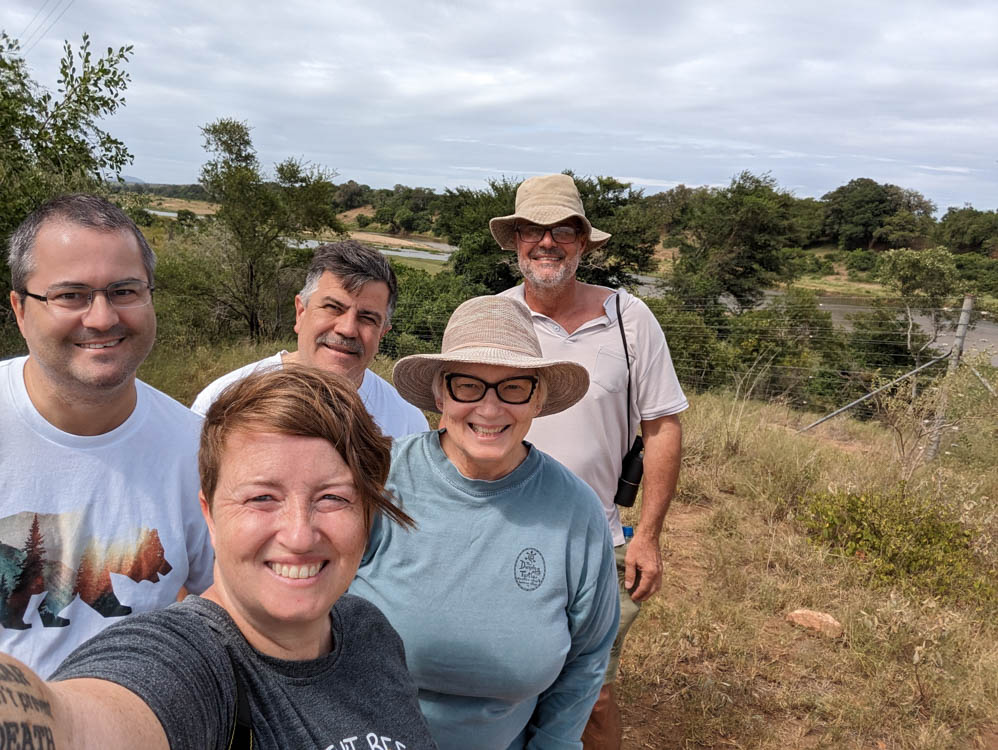
Plants
Spear Grass
By far the most interesting and memorable thing we learned about on our walking safari was Spear Grass. A nasty tall grass with a spear on the end (hence the name), it twists with moisture embedding itself in clothing and skin. When you’re out in Kruger on a walking safari, it’s best to wear long pants (and that still might not save you) to avoid the spear grass wounds.
As you walk by, the spears pierce your skin and then as you sweat the moisture activates it which then twists and spirals into your skin.
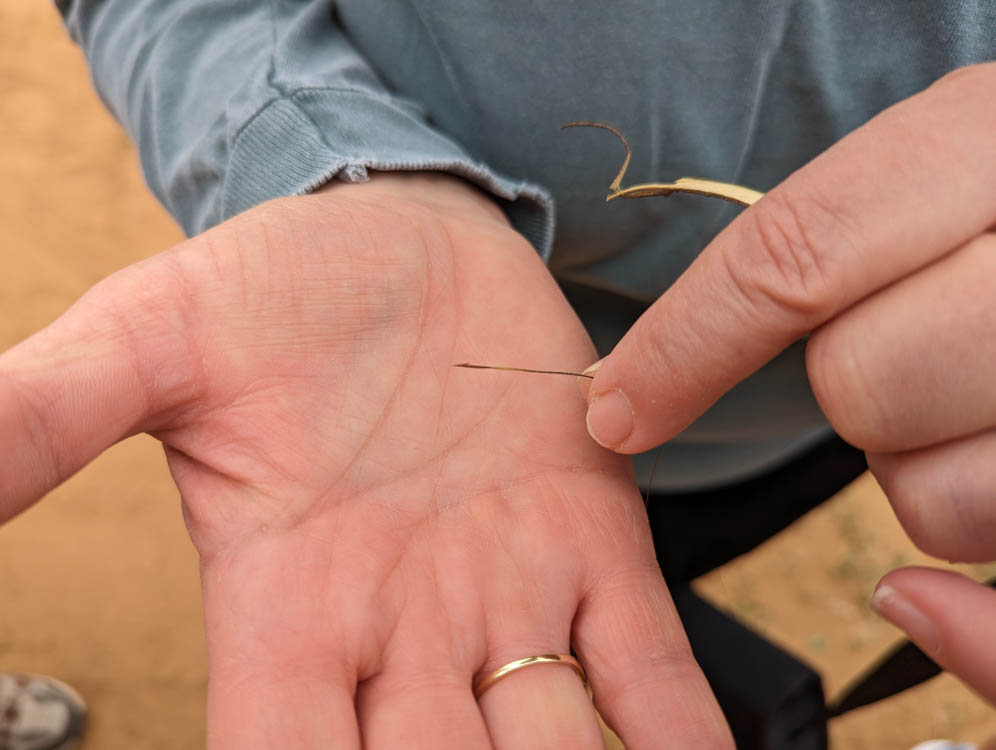
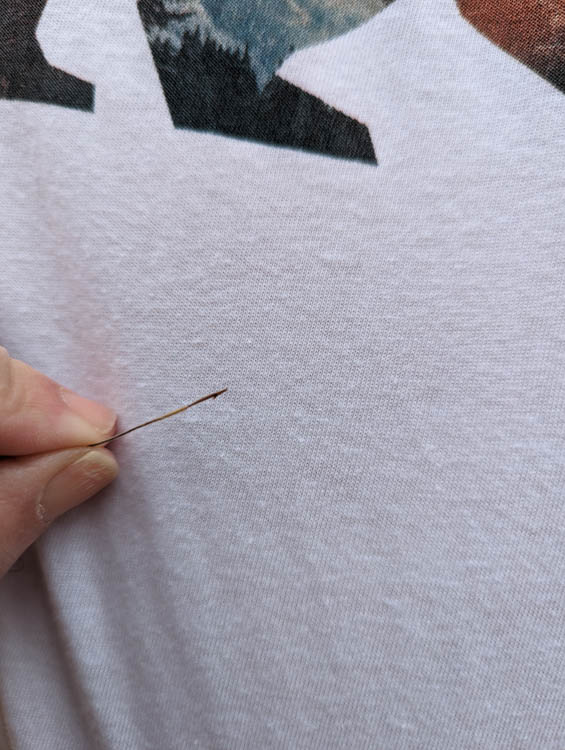
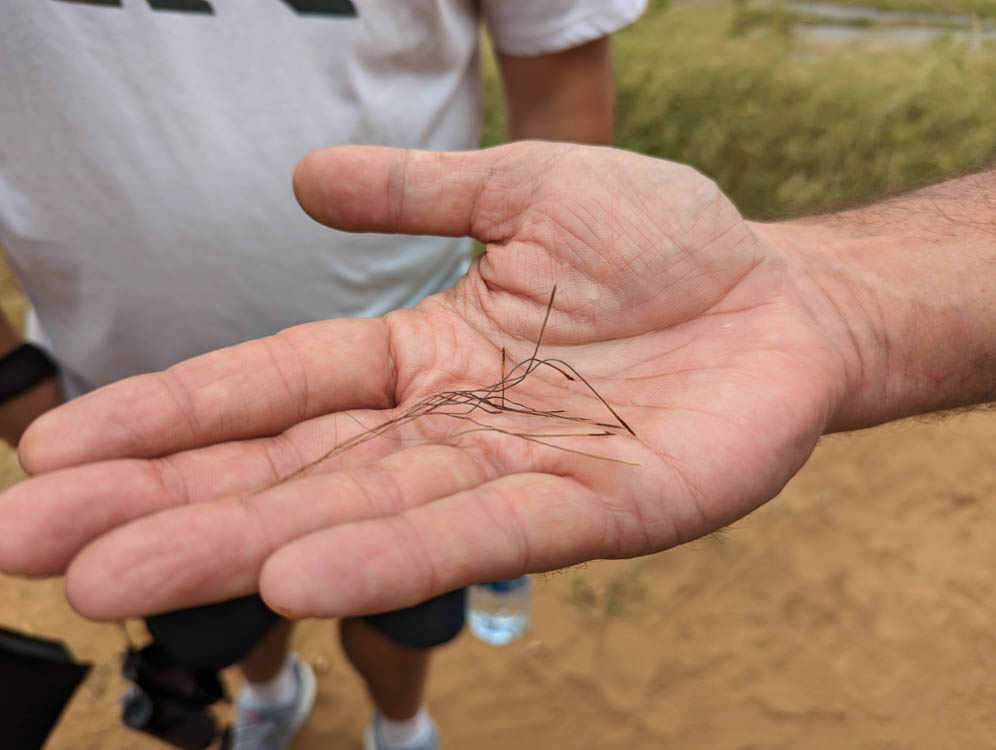
Buffalo Thorn
These are one of the giraffe’s favorite leaves and since they’re edible Rick encouraged us to give it a try. You can see my impressions in the short video below. Giraffes use their prehensile tongues to reach around the long thorns to get the supple and “sweet” (to a giraffe maybe, but they have nothing on chocolate) leaves.
Fun fact – some trees protect themselves from the giraffes by releasing a bitter taste once the giraffe starts eating. That’s why they only take a few bites and move on. The trees can pass the info that a predator is coming through the air to the next tree, so giraffes know to eat downwind from the next tree so it’s unsuspecting of its impending munch.
The buffalo thorn tree is also very valuable to the Zulu people who use the branch to carry the spirit of the deceased from where they died to their final resting place. If transported in a vehicle the branch has its own seat.
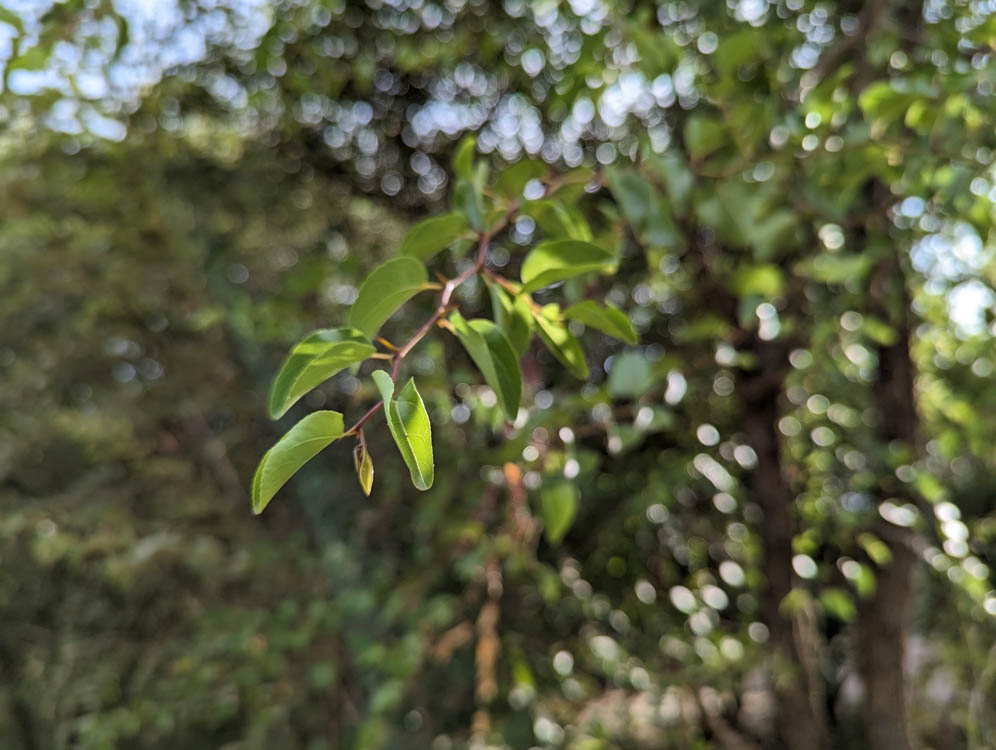

Square Stem Raisin Bush
This bush gained its name because of the square stem which you can see in the image below and for its fruit that dries out and resembles a raisin. We saw the first of the square stem raisin bushes early on in our walk and another, much larger bush, later in the walk. You can compare the young and more mature square stems.
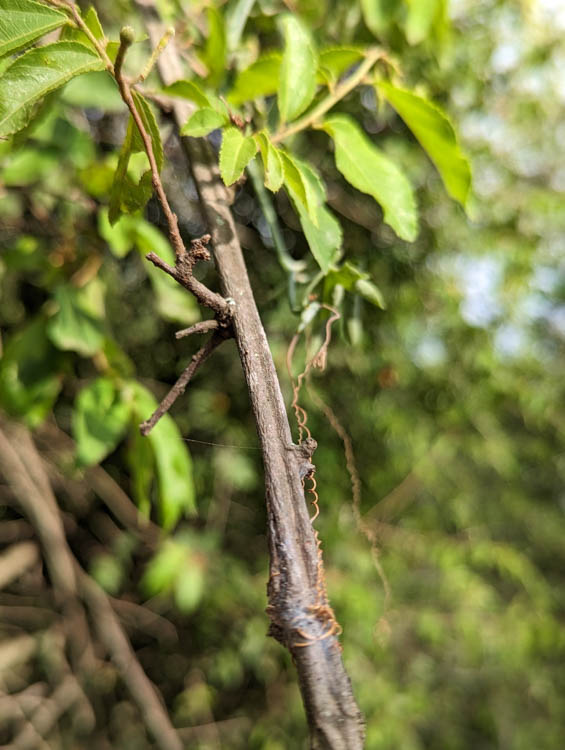
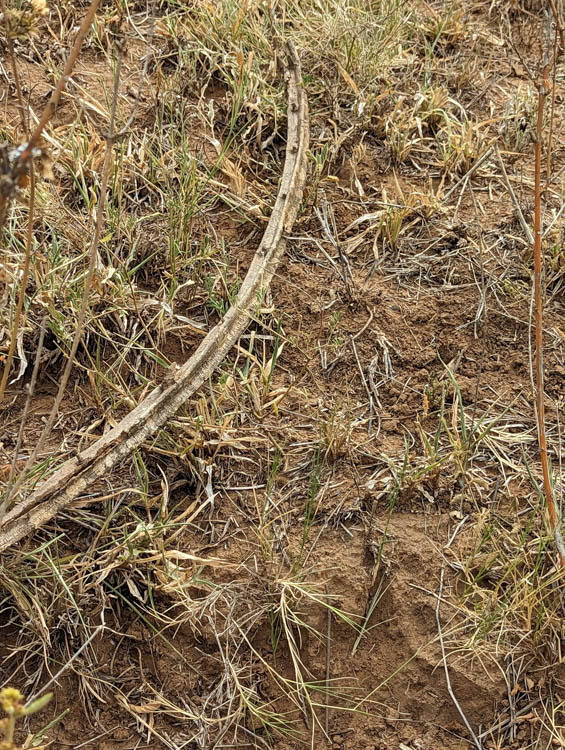
You can use the fibers of the stems to make mats and clothes. The fruit is edible, but not when it’s green or brown as seen below.

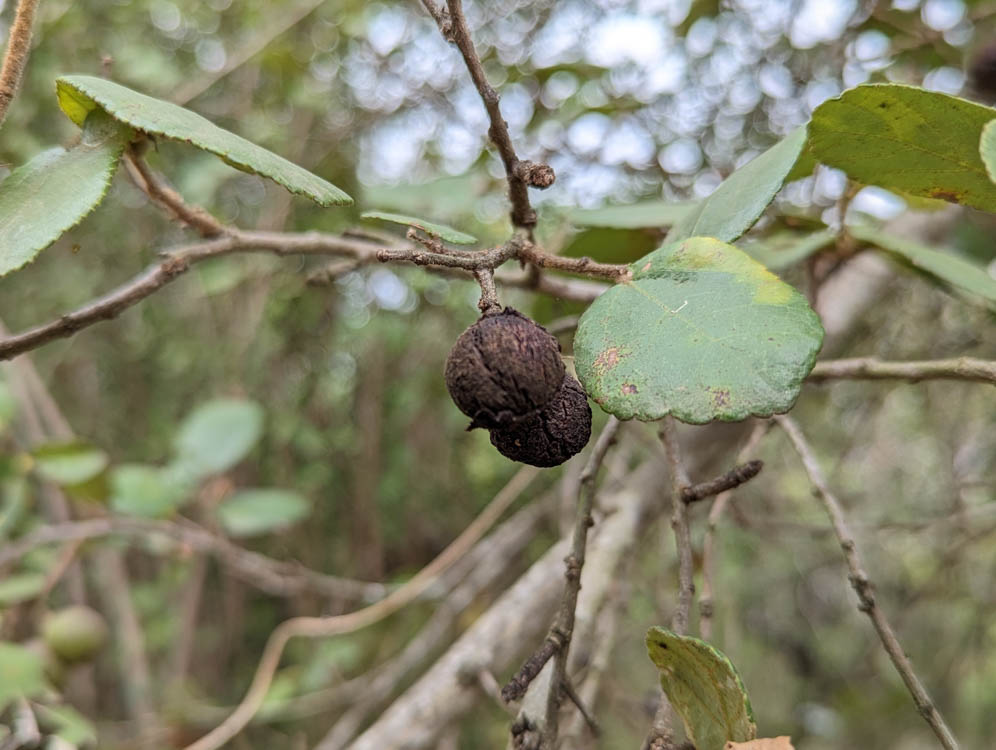
Aloe
The kudus love aloe. It has many applications for people too which you might be familiar with. In its natural form it’s bright yellow and bitter. You can put it on bites and scratches, but if a baby is nursing too much a mother might dab a small amount on her nipple to discourage the baby from nursing.
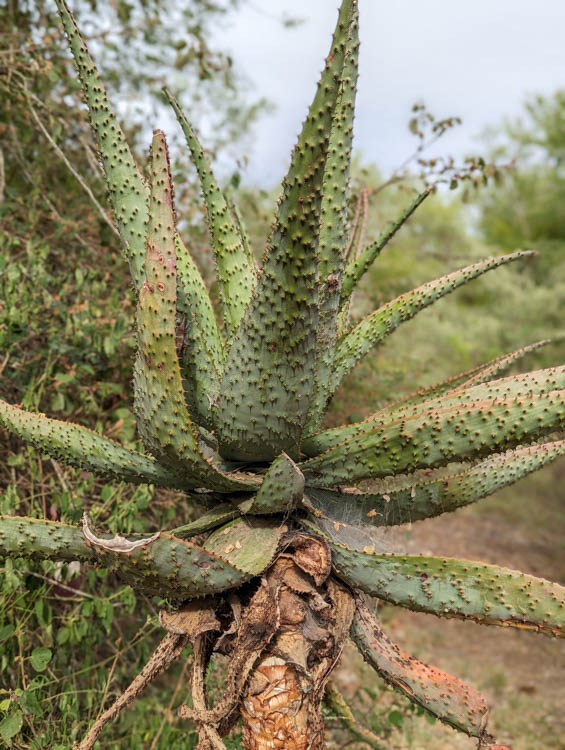
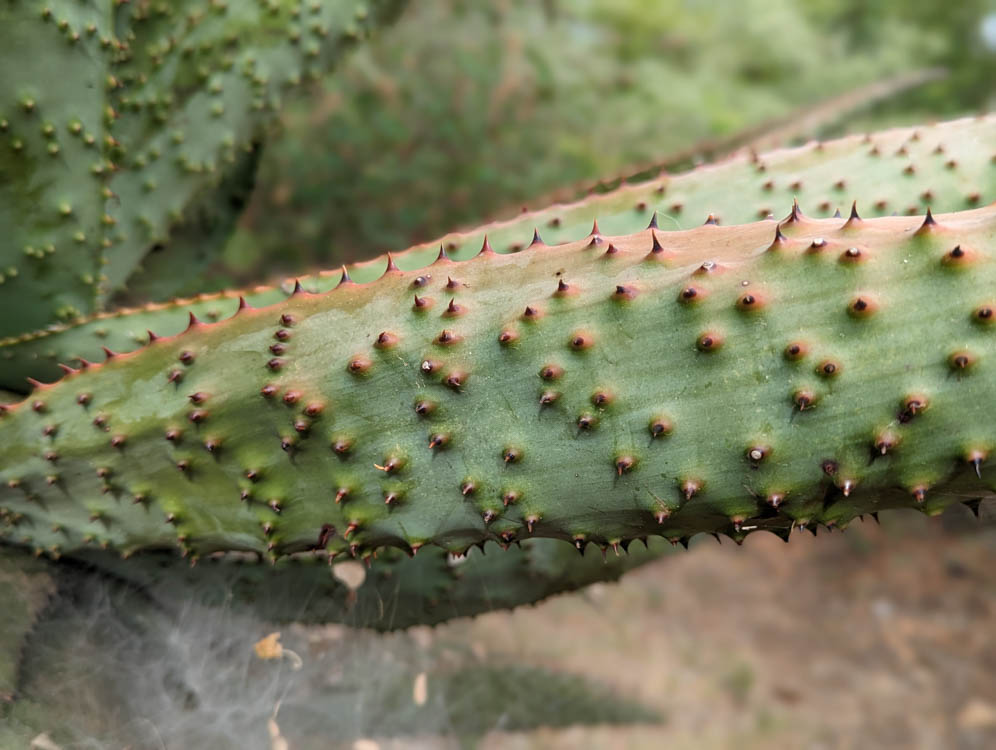
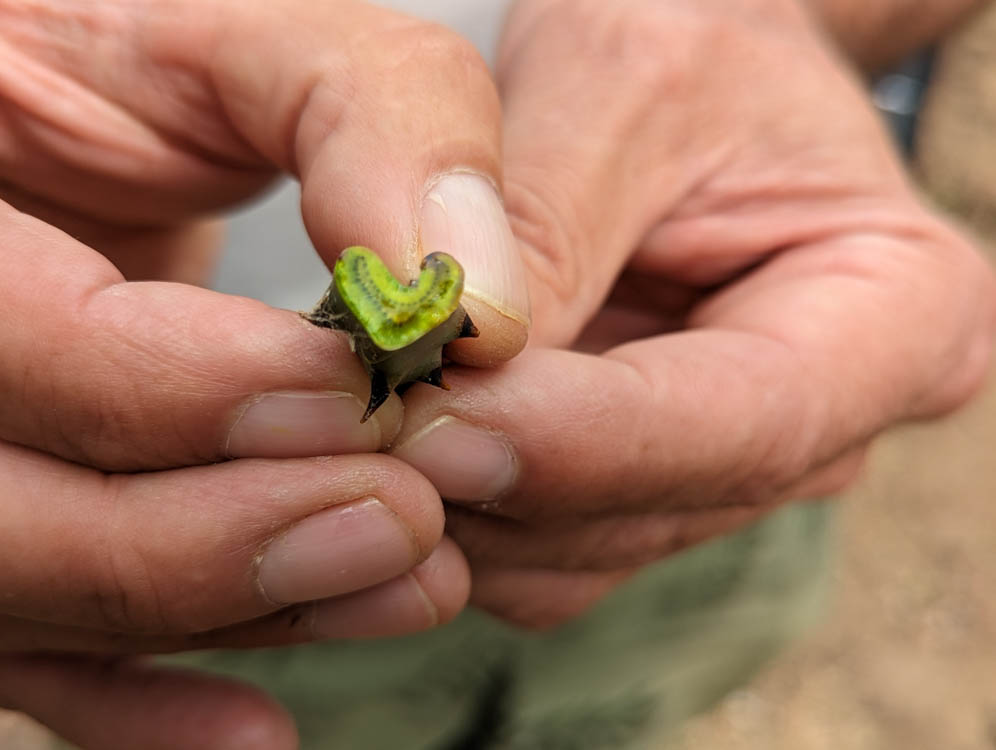
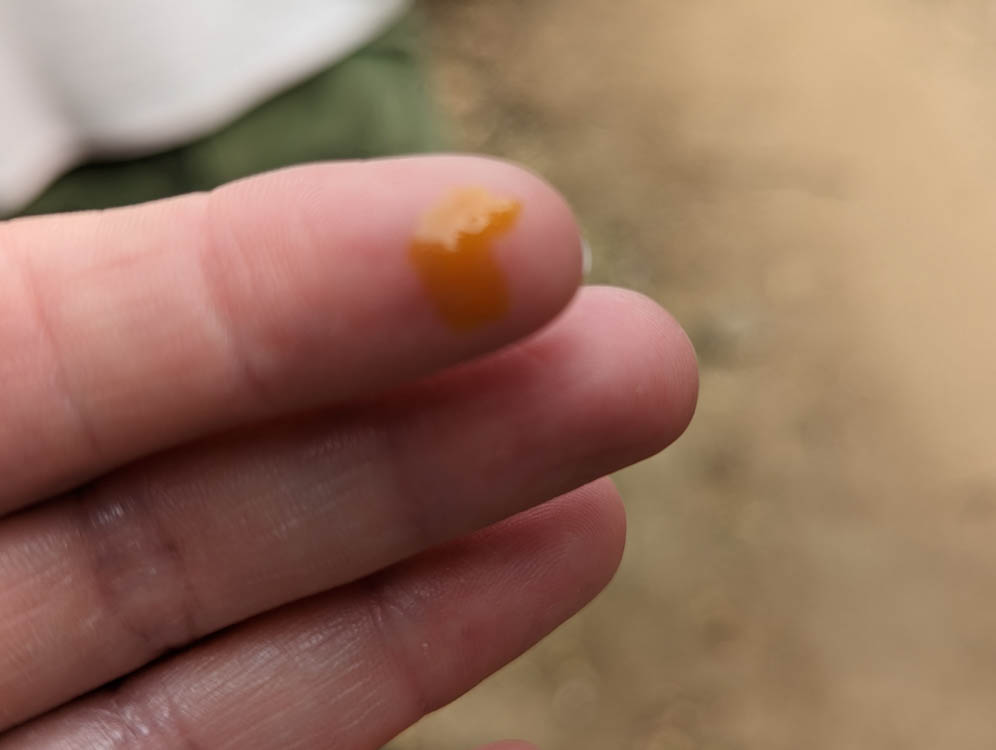
We didn’t just learn about plants though. Our walking safari also included animal scat, tracks, trees, insects and birds.
Scat
Impala poop
Impala are a species of antelope and are both browsers (which means they eat from branches of trees) and grazers (which means they eat grass from the ground).
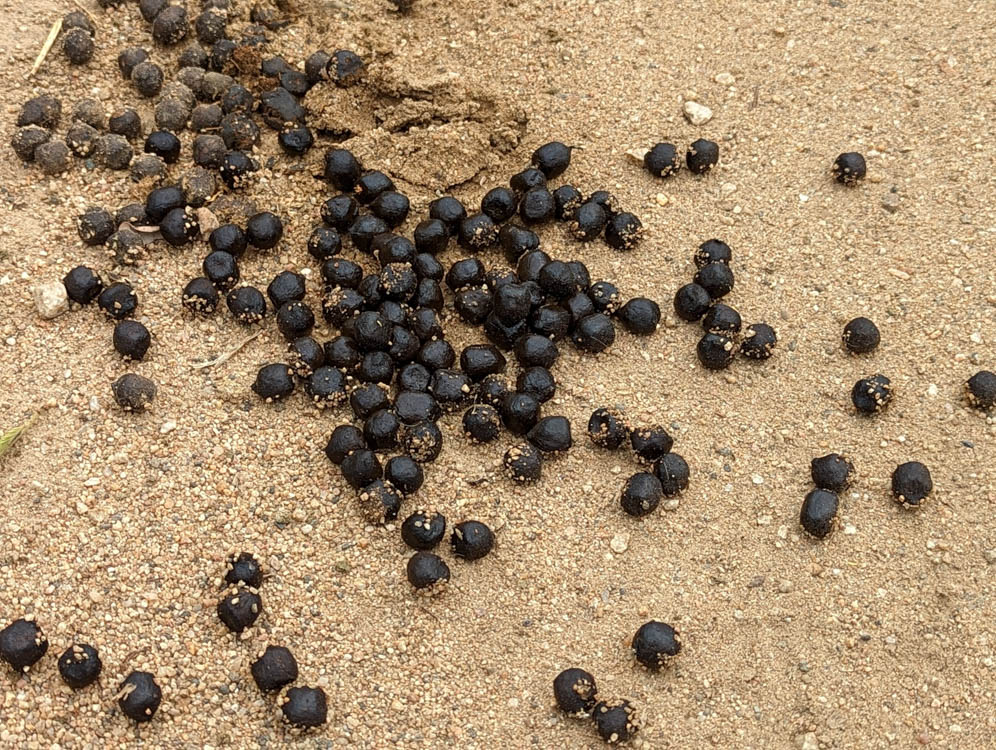
Warthog Poop
Warthogs eat on their knees because they have short necks and long legs.
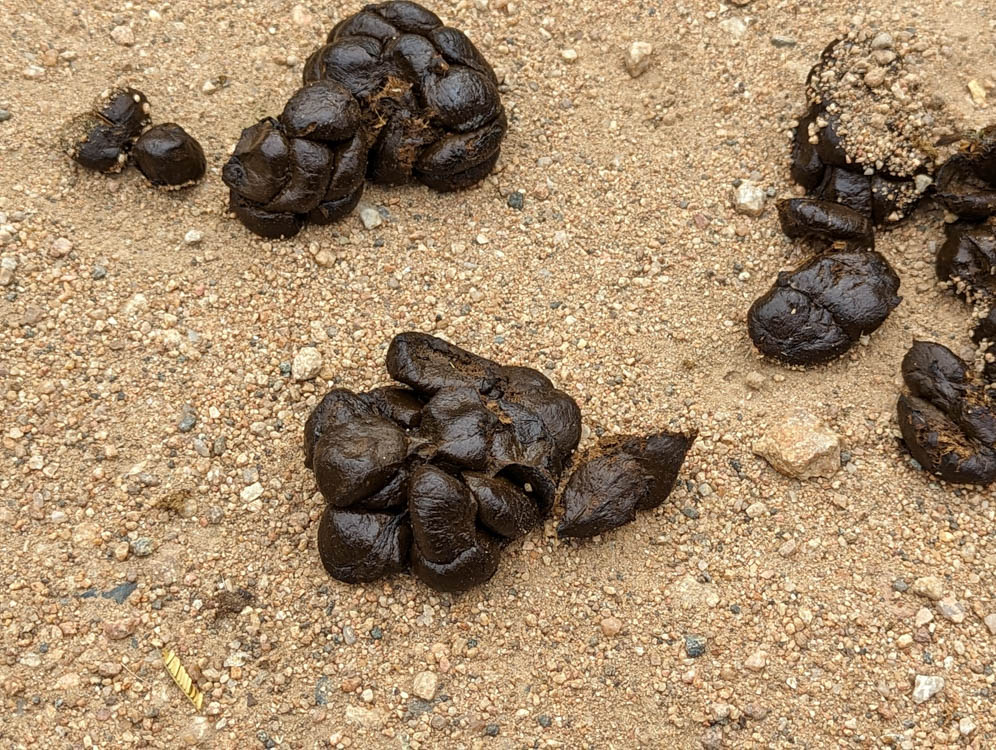
Kudu Poop
This could have been giraffe poop, but the fact that they weren’t dropped in a line, but were bunched together, tells Rick that this is from a kudu rather than a giraffe (who go while they walk).
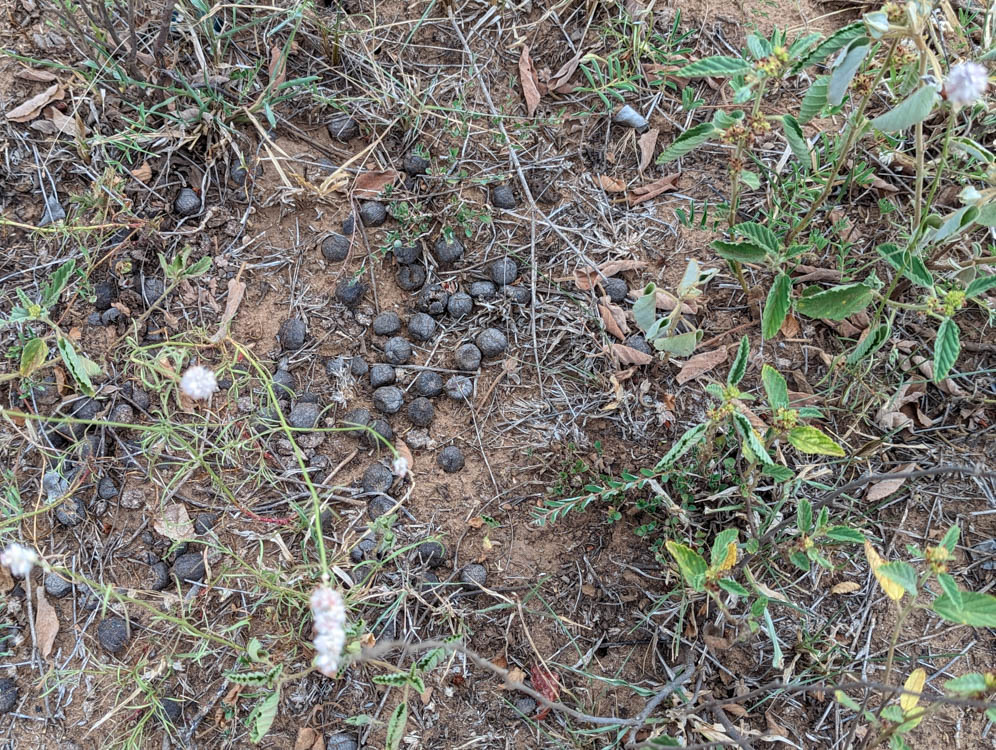
Elephant Poop
Like impala, elephants are both grazers and browsers. They eat a lot of branches and most of their food doesn’t digest properly which is why you can see so much wooden and fibrous material in this elephant poop.
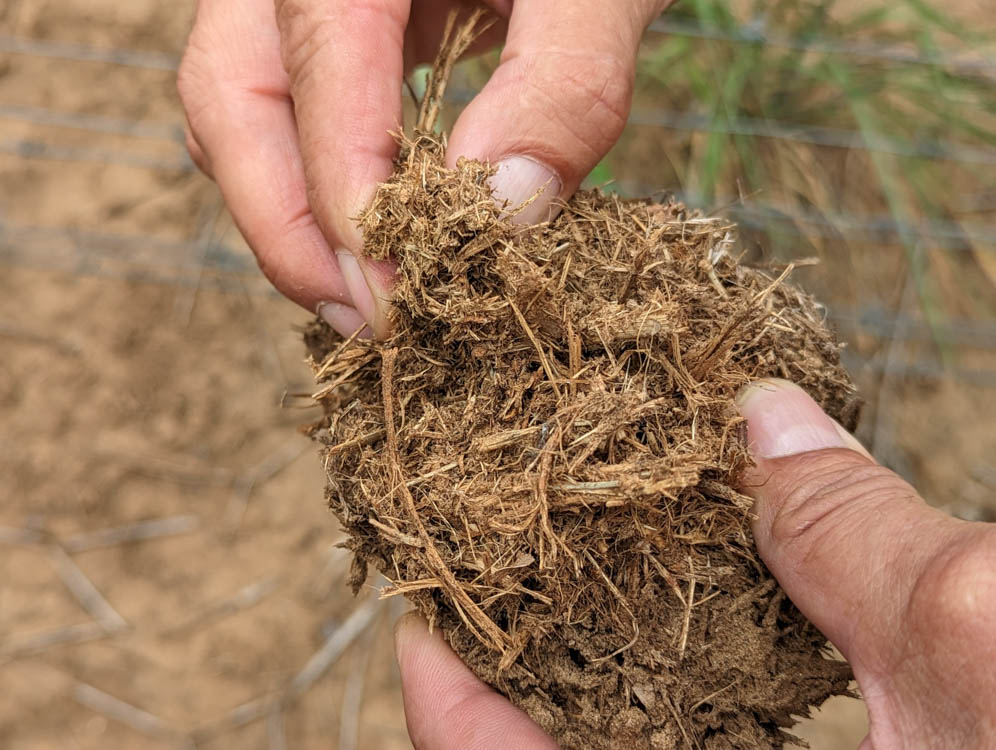
Tracks
African wildcat tracks can be seen below. We knew they weren’t fresh because there was some rain the night before and the droplet pattern was over the track pattern.
One thing that we learned is that African people will rake around their house regularly. This is so they can see any tracks from spiders, snakes or other animals that may have been on or in their properties before entering themselves.
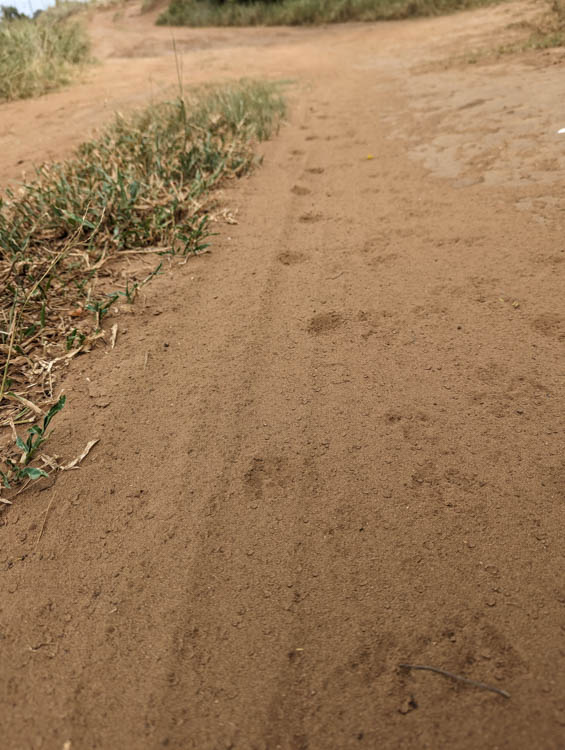
Trees
This is a jackalberry tree and is a favorite of leopards to hide themselves and their kills. There’s no guessing why – it has great coverage. Rick said that a good leopard spotting in Kruger is mainly draped tails and paws from the branches above. Our friend, Carrie, has been proving that theory wrong since we left with day after day of seeing leopards on the ground.
This jackalberry tree in Marloth Park is about 800 years old.
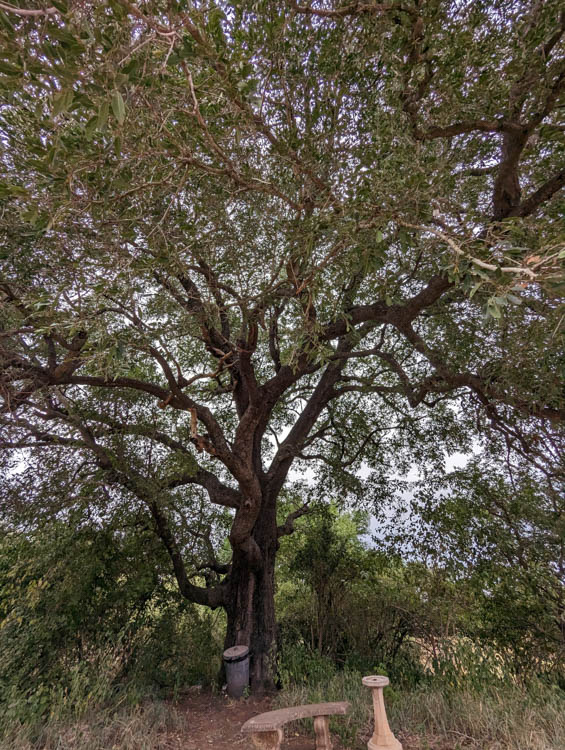
While we stood under the jackalberry tree I snapped a picture of a little moth or fly. I asked Rick about it after we walked away. His response: “Where did you see that!? You didn’t touch it right!?”
Insects
Processionary Caterpillar Moth
It turns out that what I’d seen was a processionary caterpillar moth. It can cause skin rashes and irritation so should be avoided – that’s why they have such distinctive markings that say “warning!”
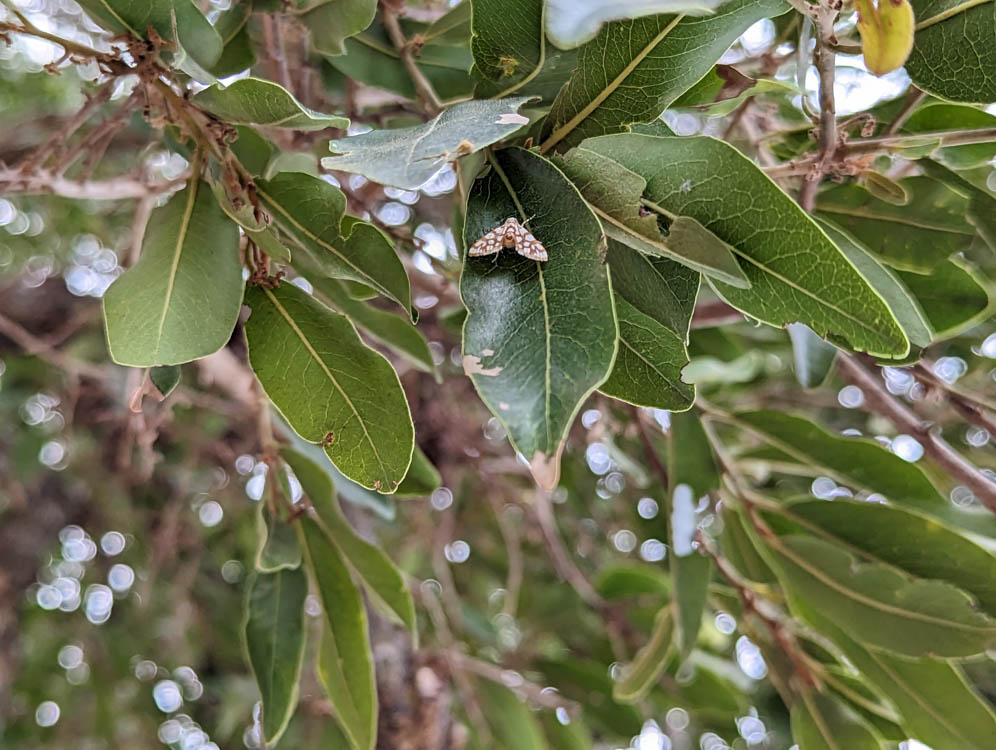
Dung Beetle
If you saw my pictures from Kruger then you know a bit about these guys already, but why is it on a barbed wire spike? Most likely it was saved here by a bird for a later meal.
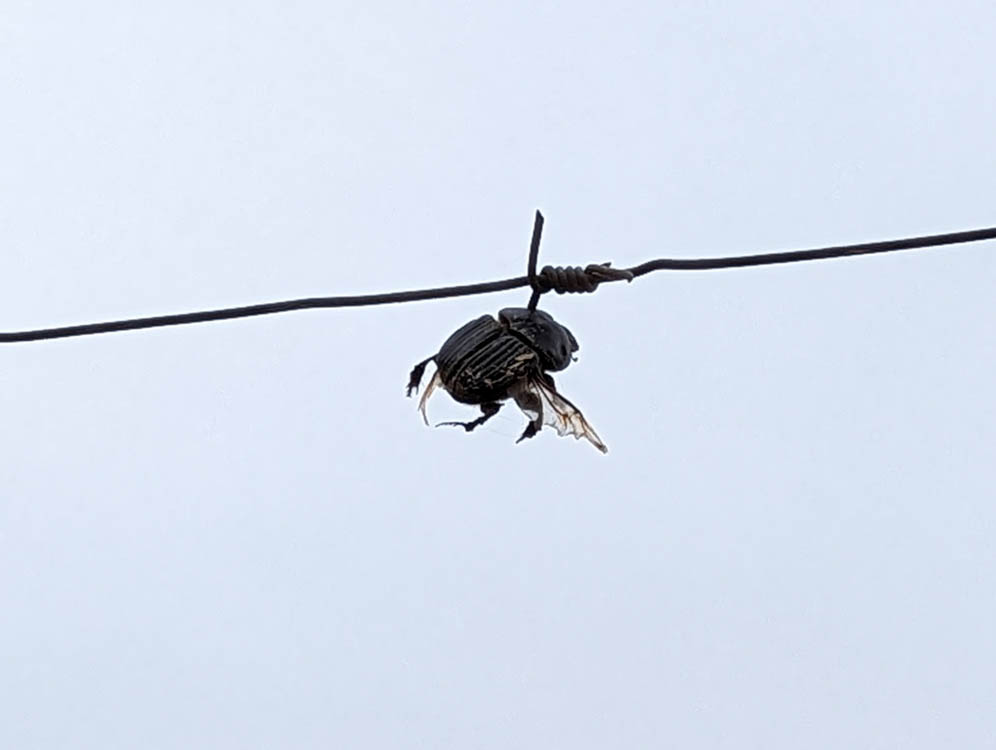
Birds
We did see several birds along our walk. Storks, yellow-billed kites, LBJs (little brown jobs) – also known as rattling cisticolas – and a great white egret. None of my pictures of them are anything to write home about (or to blog about either I guess), but there were a couple of interesting nests to share.
These are bee keeper nests in the wall of a gully that we passed through on our walking safari.
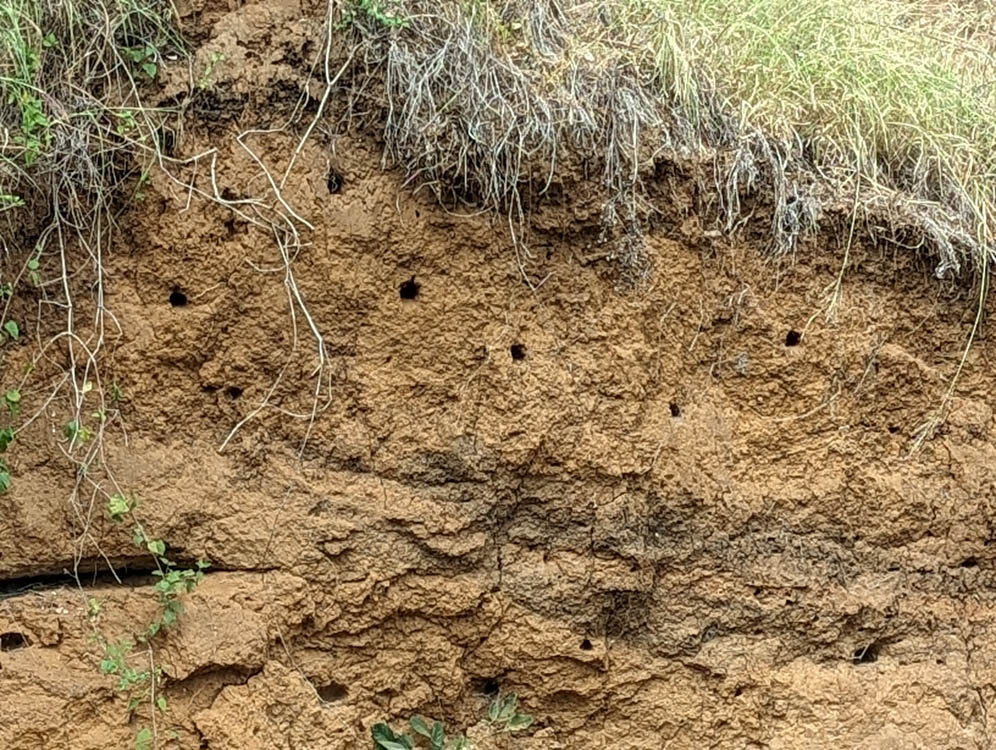
We also saw the little nest below and wandered over. One of the fun parts about a walking safari is getting to go at your own pace and learning about what interests you. This was a singular weaver’s nest – which are usually in groups. This one had an abandoned egg inside.

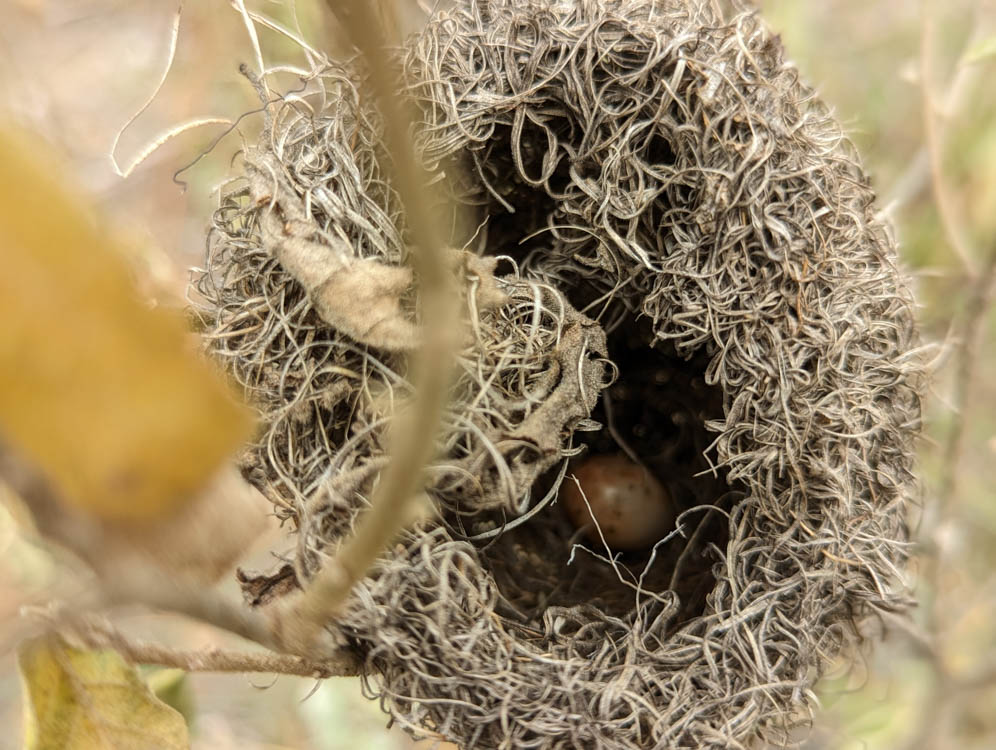

Animals
We saw a few animals while on our tour of Marloth Park as well. We saw a leopard tortoise (close-up), crocodiles, water bucks and hyenas across the river from us. That’s the Crocodile River that we crossed to head into Kruger National Park during each visit. There was a “cat hole” in the fence line for the lions and leopards to cross back and forth (yes, you don’t go out walking between 6pm and 6am as that’s predator hours.) Carrie and Jim live a short walk from the river and regularly see elephants, hippos and more close to the fence and along the river.
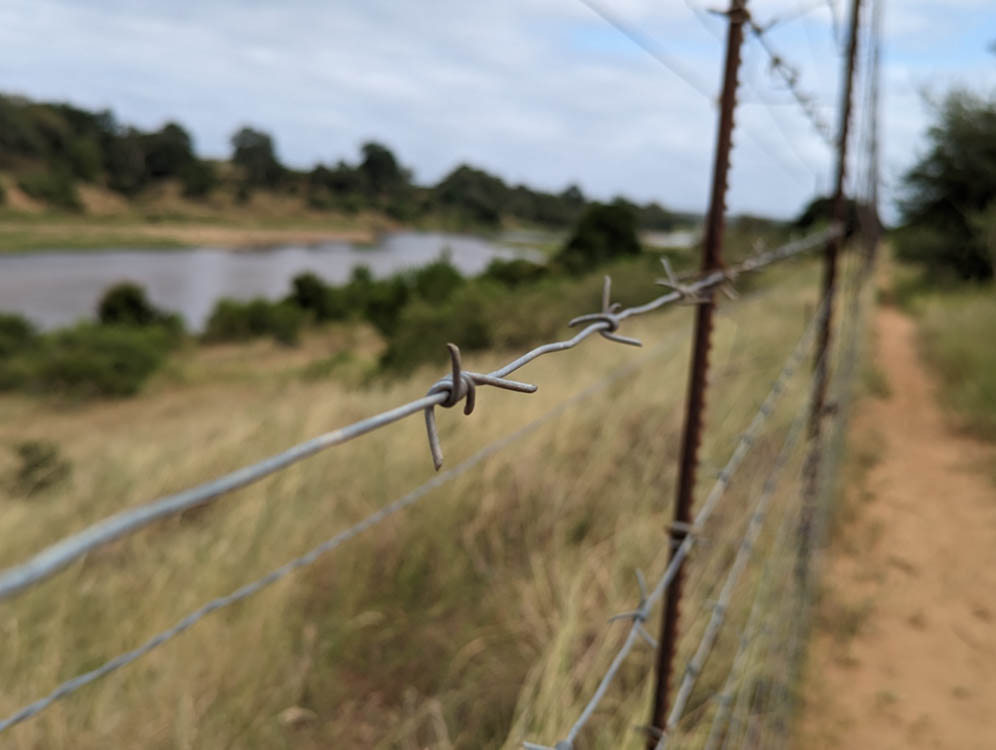
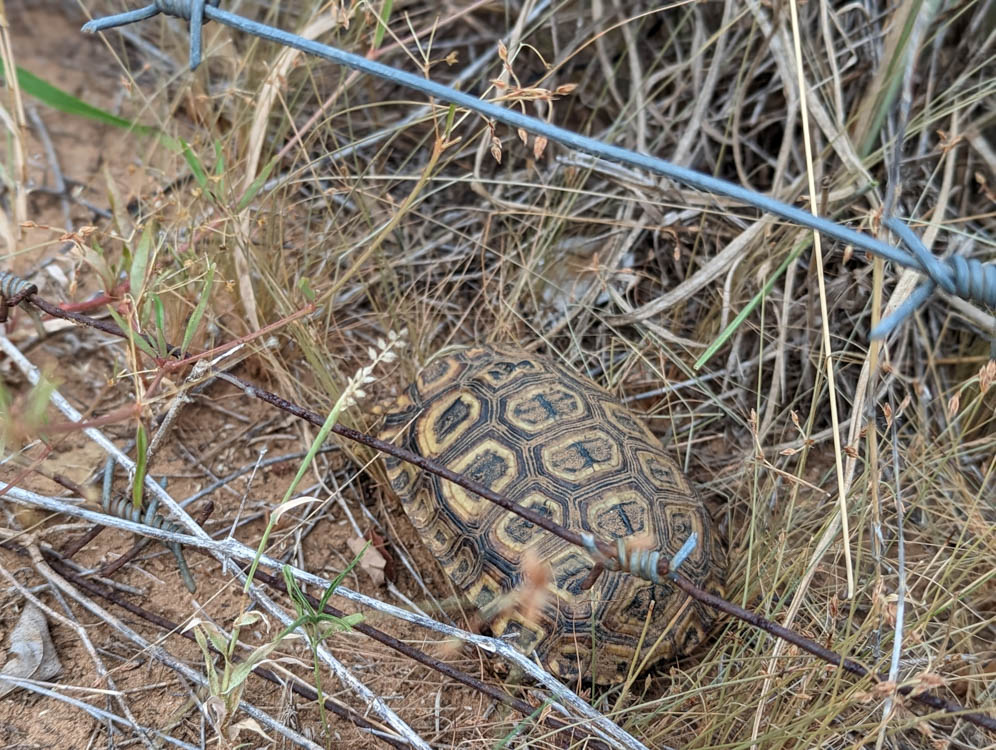
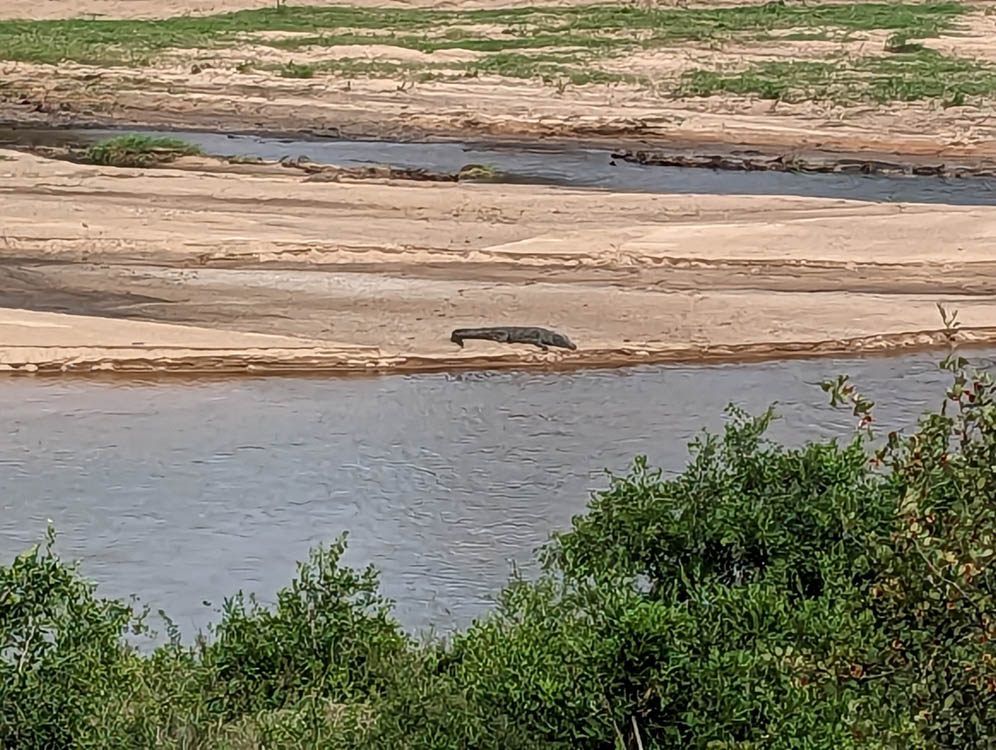
That’s the end of our amazing walking safari in Marloth Park. I’ll turn it over to Stephen to tell you about the wildlife we saw around the park and in our very own backyard at Carrie’s Backyard Zoo!
Marloth Park Animals
Marloth Park is a community in South Africa that was originally set up in the 1970s as a holiday town where people would stay when visiting Kruger National Park. Well, it’s since also become a popular place for people to live in full-time, such as our friends Carrie and Jim.
It’s just outside of Kruger National Park; as Shae showed in one of the photos above, you can walk along the fence separating Marloth Park from Kruger. To help give an even better sense of its location, you can see Marloth Park circled in red on the map below; everything in dark green above it is Kruger National Park.
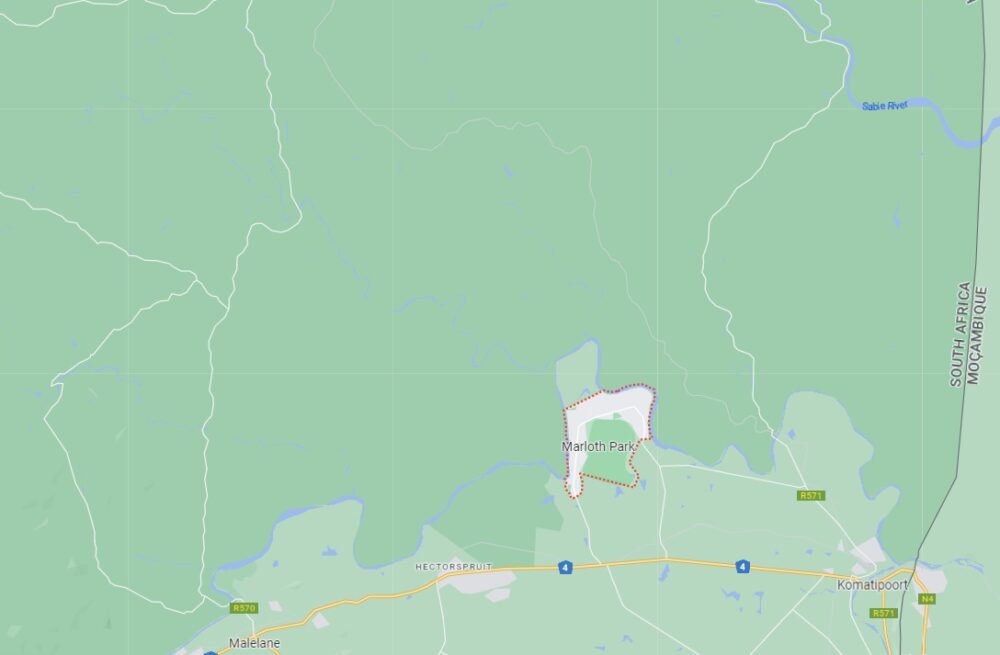
Due to its proximity to Kruger, many of the animals that you find inside the National Park can also be found in Marloth Park. Here’s a collection of what we saw.
Impala
Almost as soon as we entered Marloth Park we started seeing impala by the side of the road.
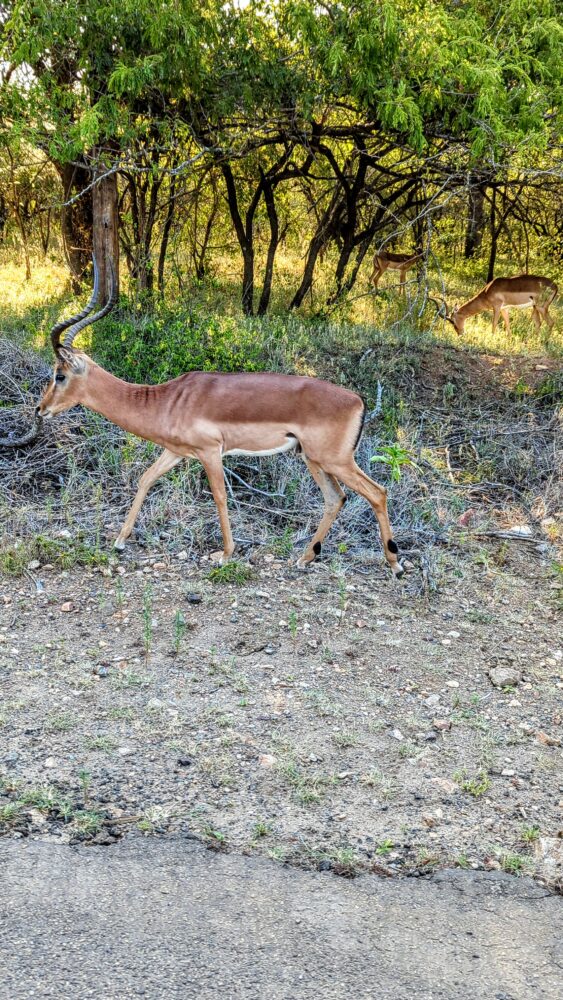
Impala were also incredibly common in the backyard where we were staying too. They’re such cute little animals.
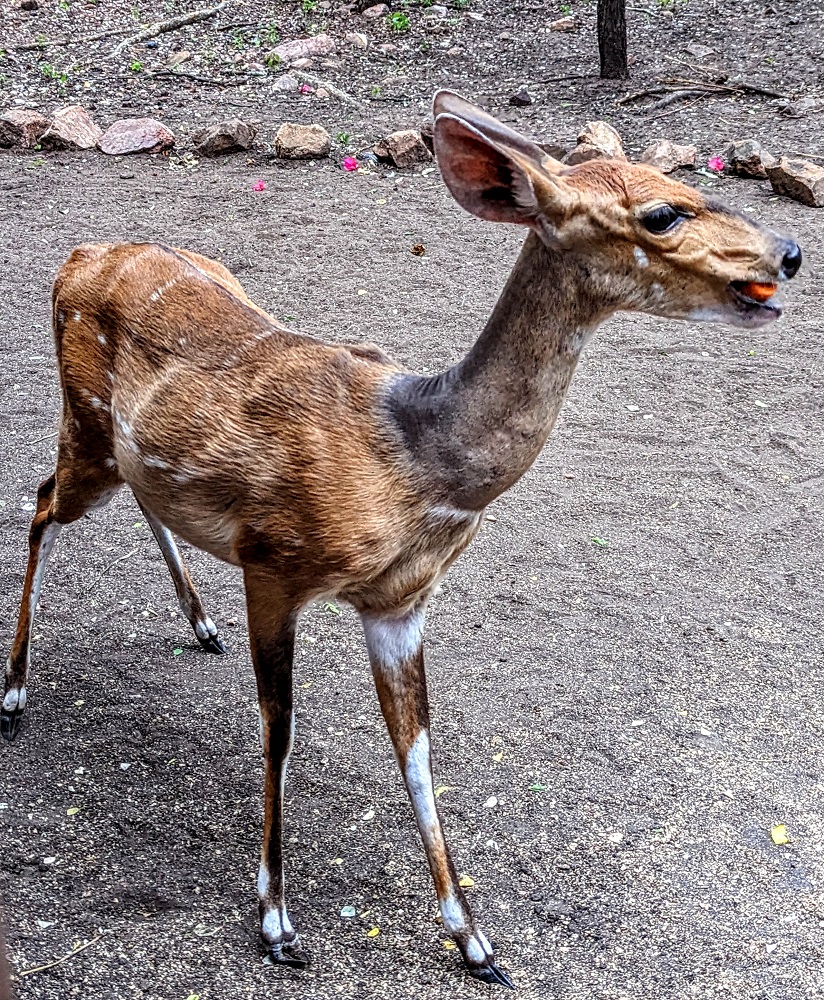
Giraffes
On our first morning we drove into Kruger National Park, but it took us longer than expected to get there. That’s because we kept seeing wildlife as we left Marloth Park, including this giraffe enjoying some breakfast outside someone’s home.
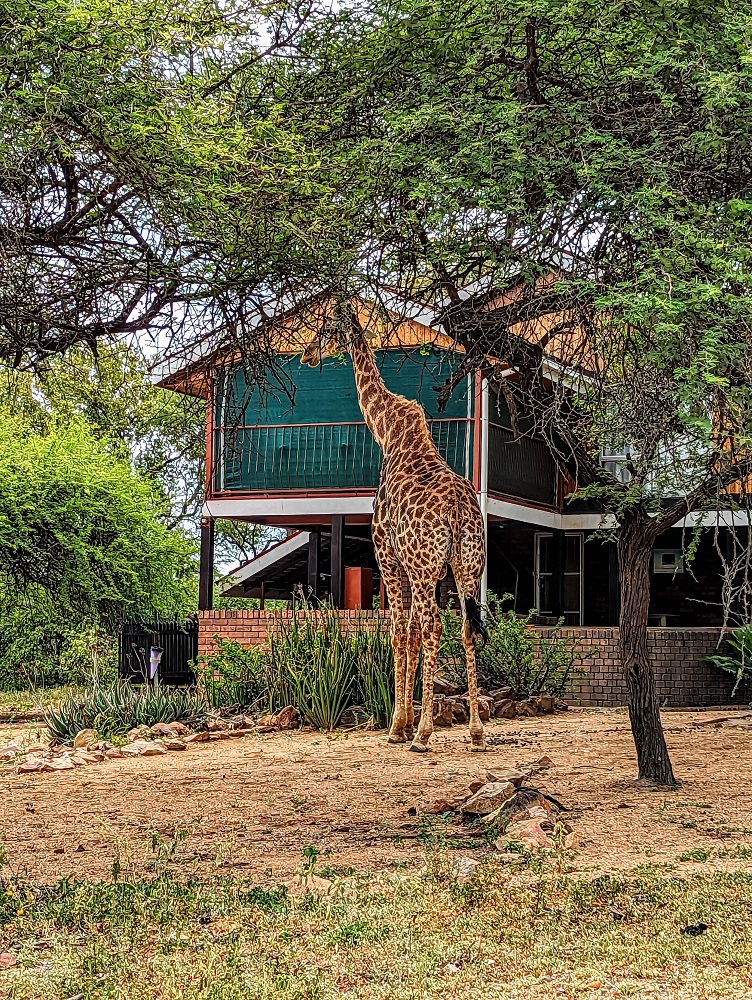
Some of our best giraffe sightings came on our last night though. There was a giraffe in the front yard of our friends’ home, so we went outside to take a look. It turned out there were about half a dozen giraffe around and so we got to see them incredibly close.
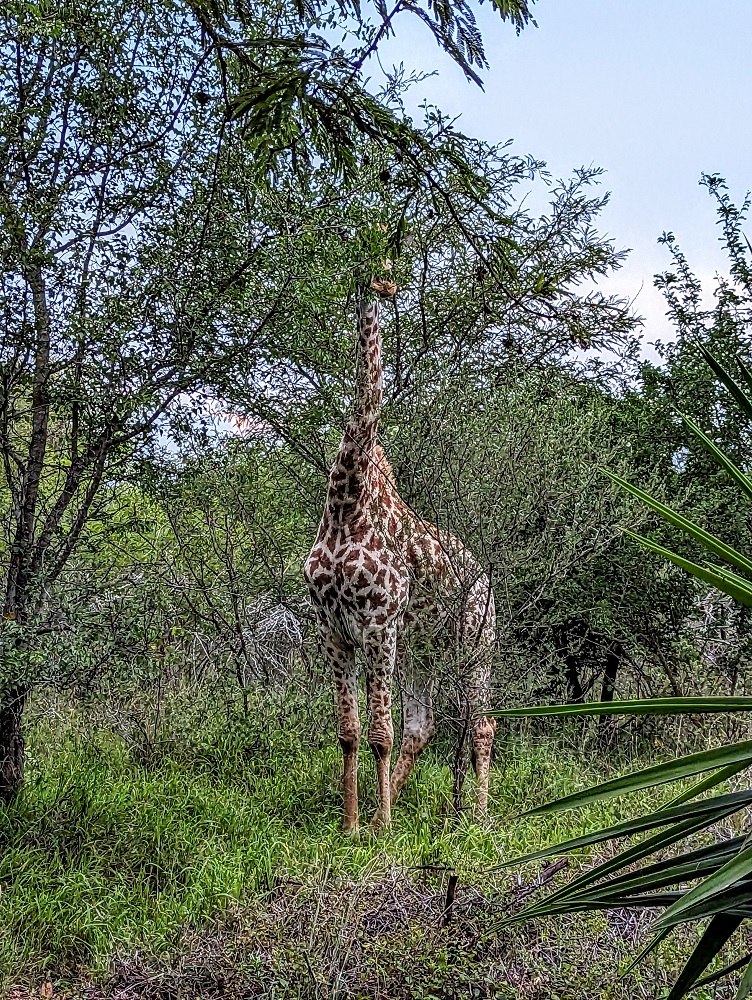
We’d gotten to see plenty of giraffes in Kruger National Park while driving around there, but there was something magical about standing so close to them in a residential neighborhood.
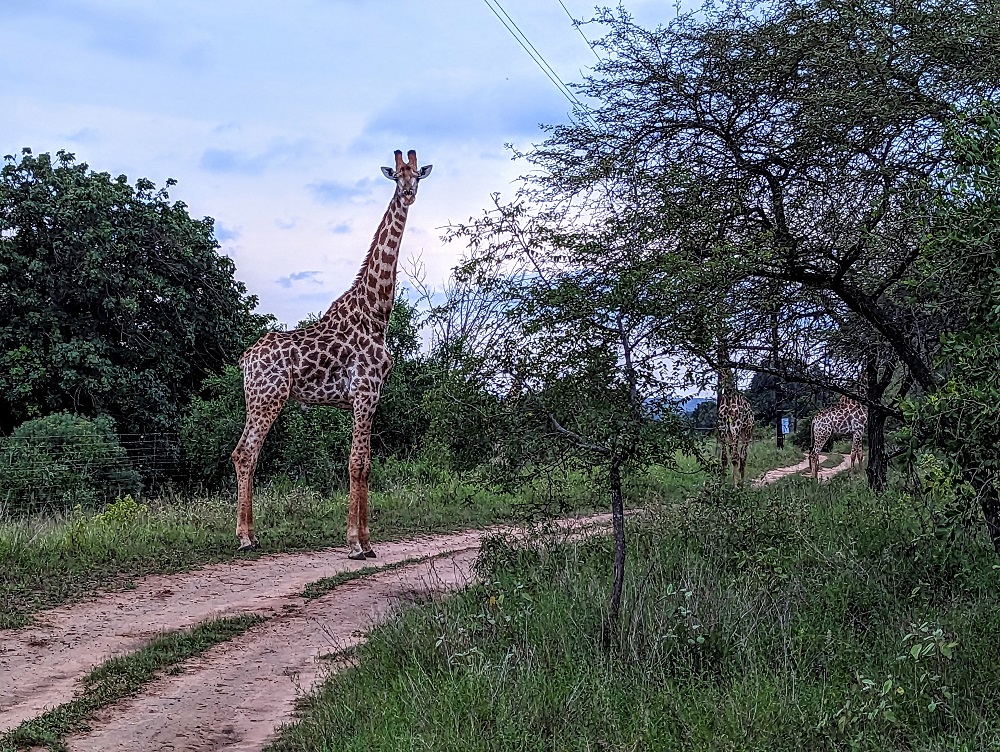
To give a sense of how close they were, here’s a photo from their front yard; that’s Shae’s mom taking a photo as a giraffe walked even closer to us.
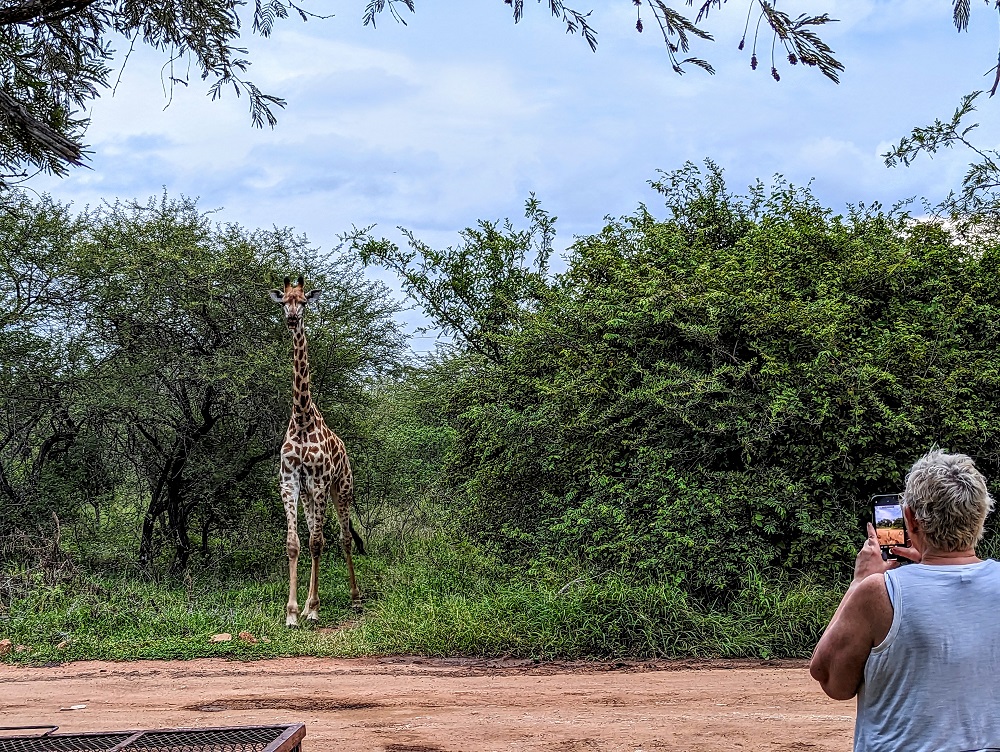
Warthogs
We usually didn’t even need to walk out the front of the house to see critters. That’s because wildlife was often plentiful just outside their backyard. Some frequent guests were warthogs; due to the time of year we visited, we also got to see some baby warthogs. It was so fun watching warthogs eat because as Shae mentioned earlier they often eat while kneeling down.
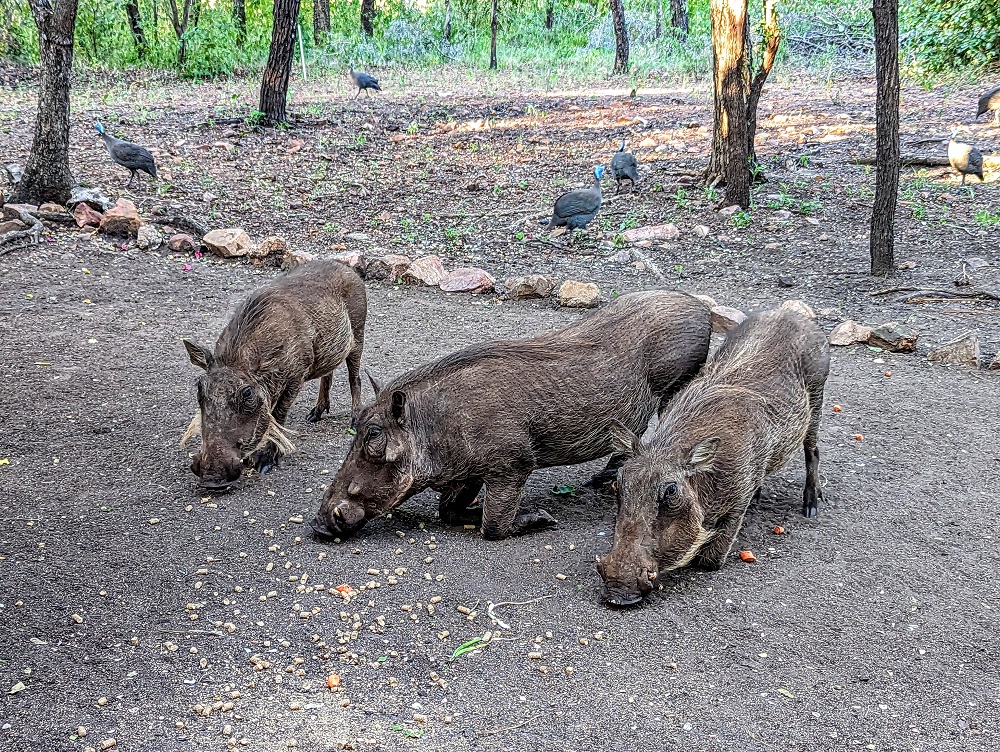
Although they’re not cute in a conventional sense, there was something very sweet about them.
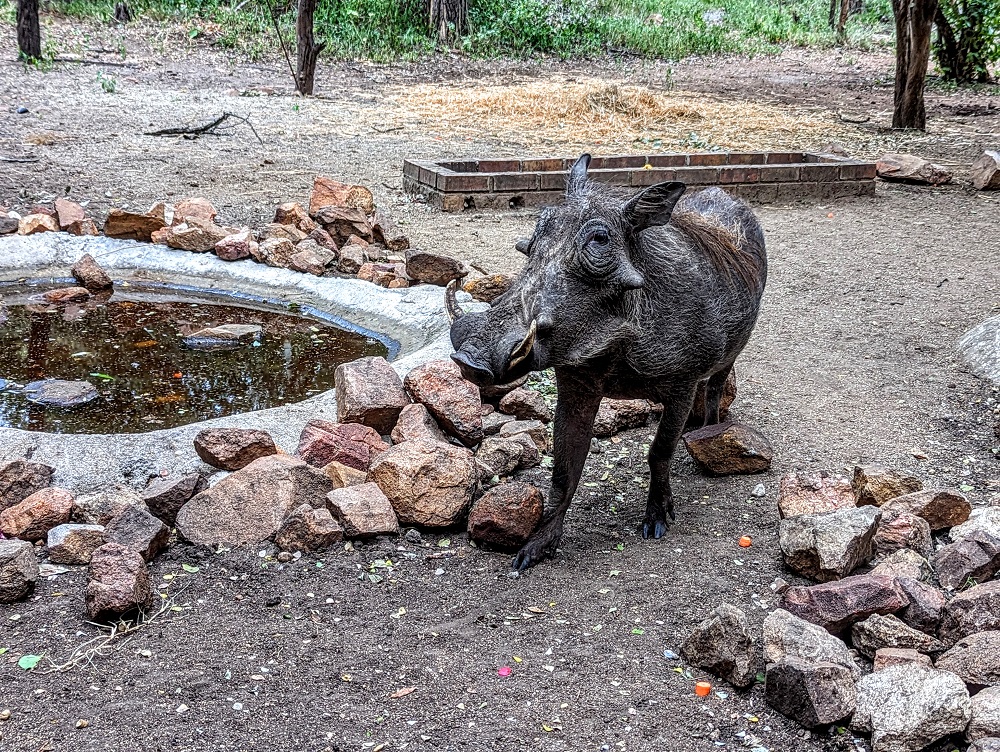
Lesser Bushbaby
An animal that is ridiculously cute though is the lesser bushbaby. It’s a nocturnal animal that looks like something out of a cartoon, or a Ty Beanie Baby come to life.
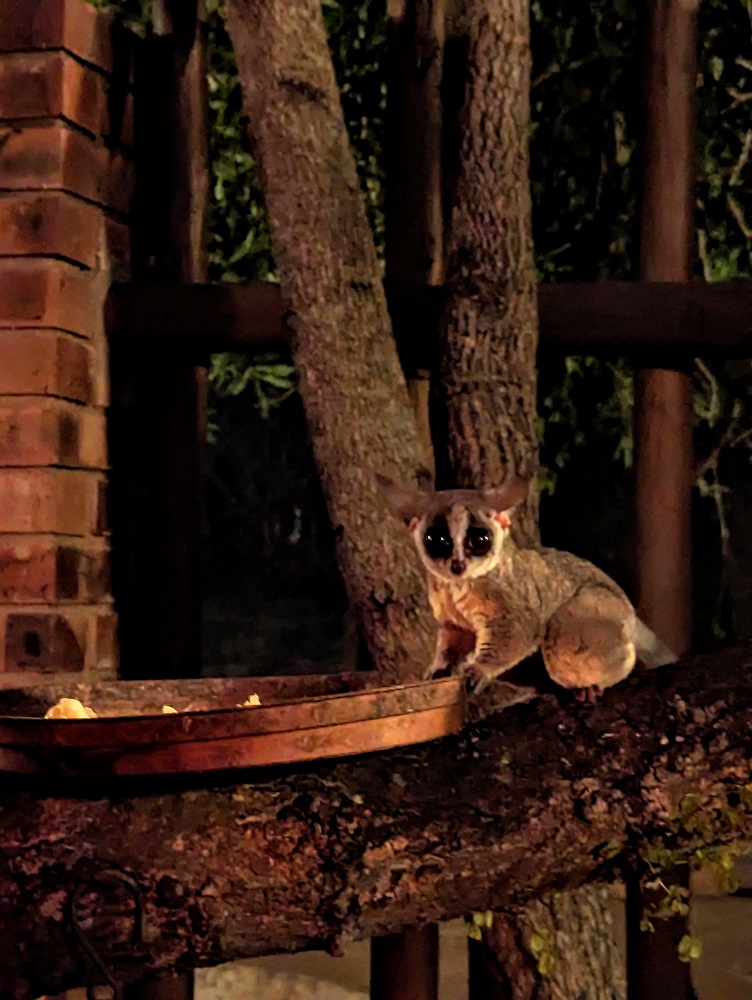
Our friends have some trays set on tree branches where they leave out yogurt and bananas for the bushbabies. Every night without fail they’d show up; they were a little skittish and constantly seemed to be turning their heads around to look for predators, but despite that we still managed to get a few good photos of them. That was something of a miracle because using Night Sight on our Google Pixel 6 phones requires that the subject – and the photographer – stays still.

Thick-Tailed Bushbaby
In addition to the lesser bushbabies that are quite small, at night they were also visited by thick-tailed bushbabies. These looked like cats while they walked along the top of the fence posts, but once you could see them a little more clearly it was obvious they weren’t felines.
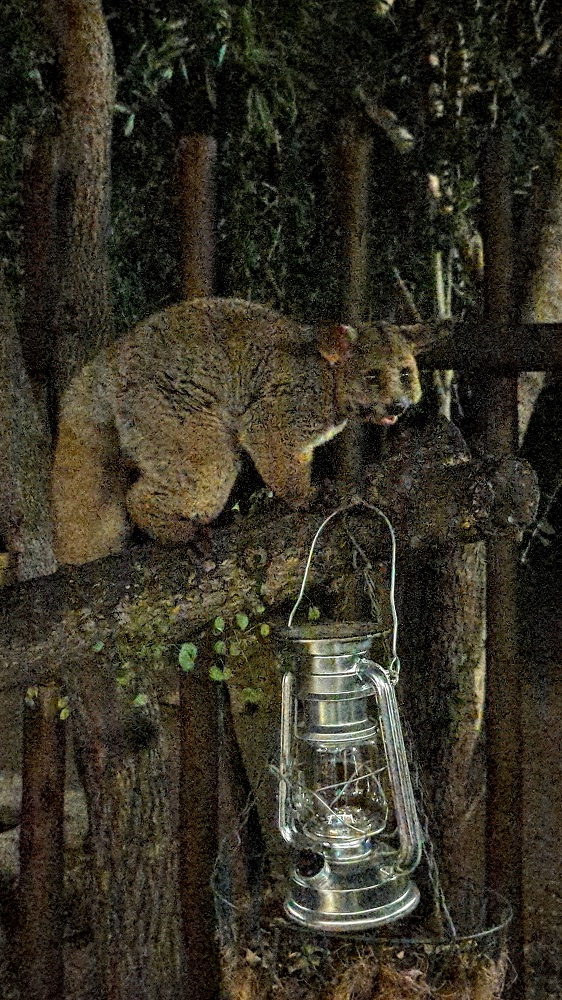
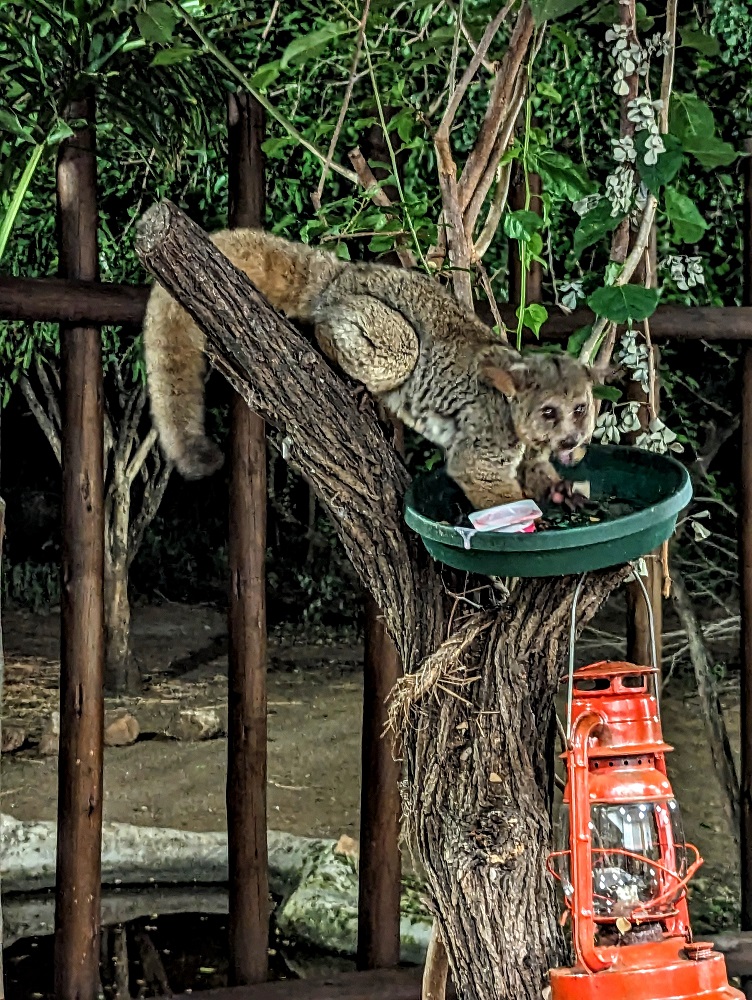
This thick-tailed bushbaby looked like he’d been caught in the act.
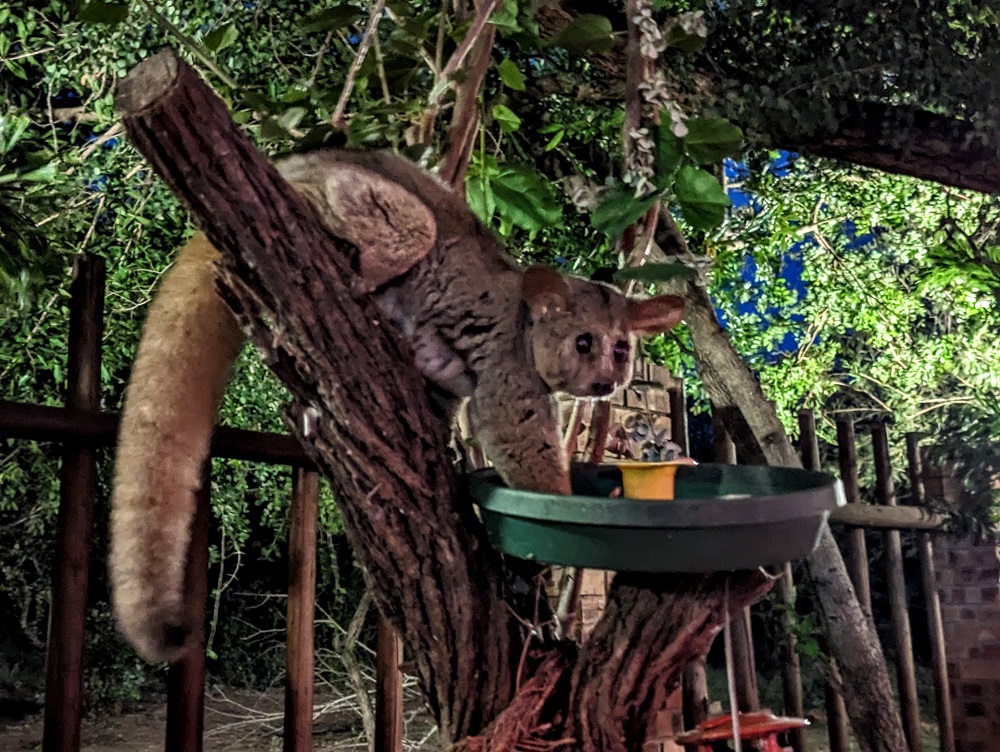
Kudu
Kudus have tremendous corkscrew-like horns. They look like they’d be prone to getting their horns caught on tree branches, but they know exactly how to avoid that happening.
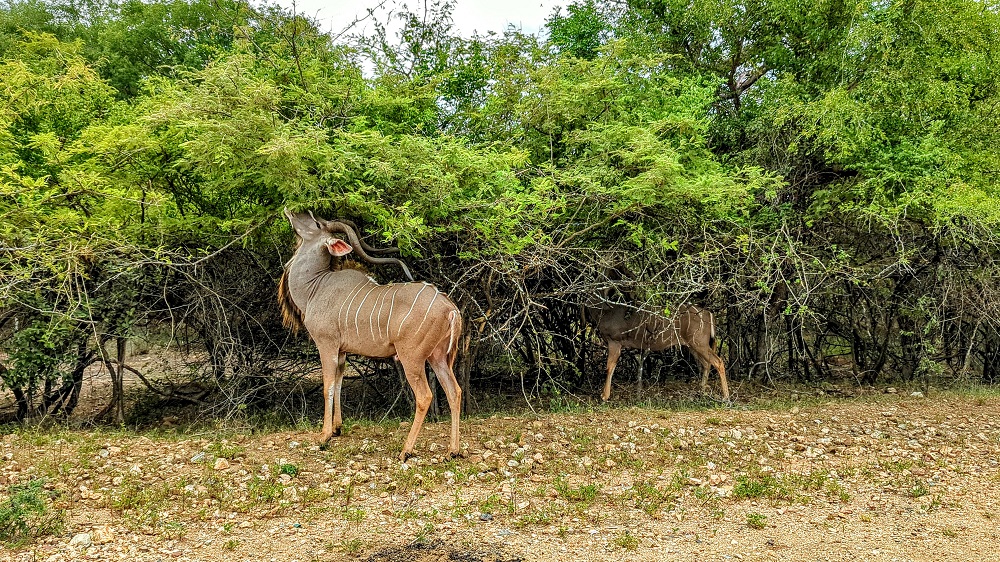
Those massive horns make them look more imposing than impala, but there’s also something regal about them. Despite that, they can also look very sweet which Shae captured perfectly with this photo.
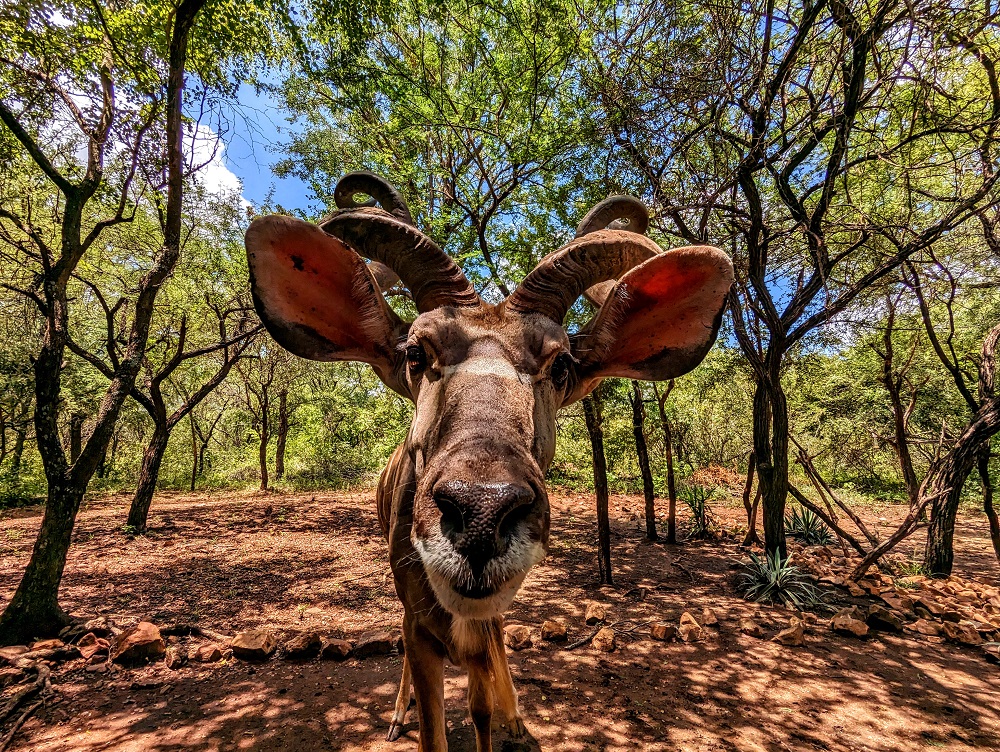
In case you’re wondering, we didn’t stand out and about with all these wild animals as that wouldn’t be safe. Their backyard had wooden fencing around it to prevent animals from getting in, but with wide gaps between the fence posts so we could still see the animals clearly.
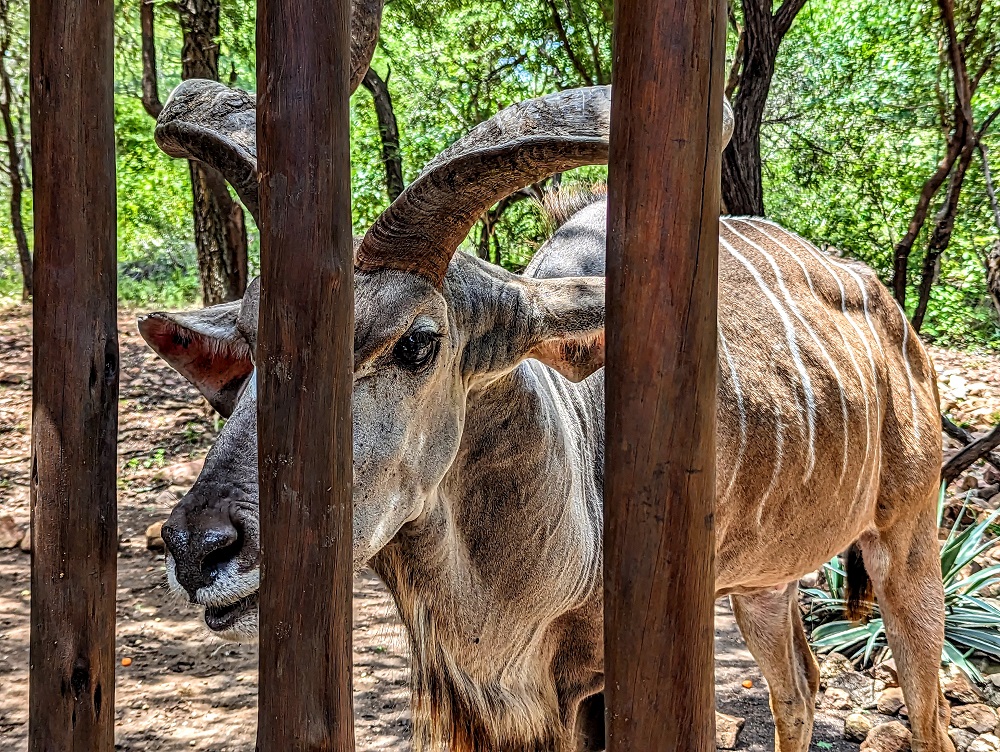
Wildebeest
Other than impala and warthogs, the animals that we saw most frequently in Carrie and Jim’s backyard were wildebeest.
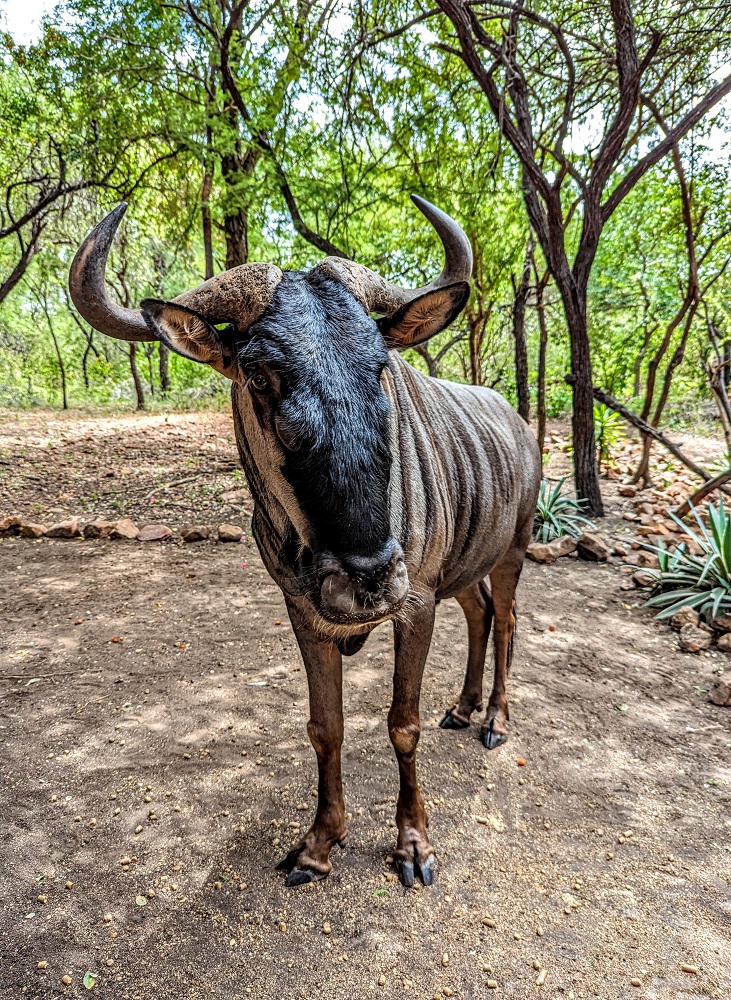
It wasn’t unusual to see half a dozen of them or more.
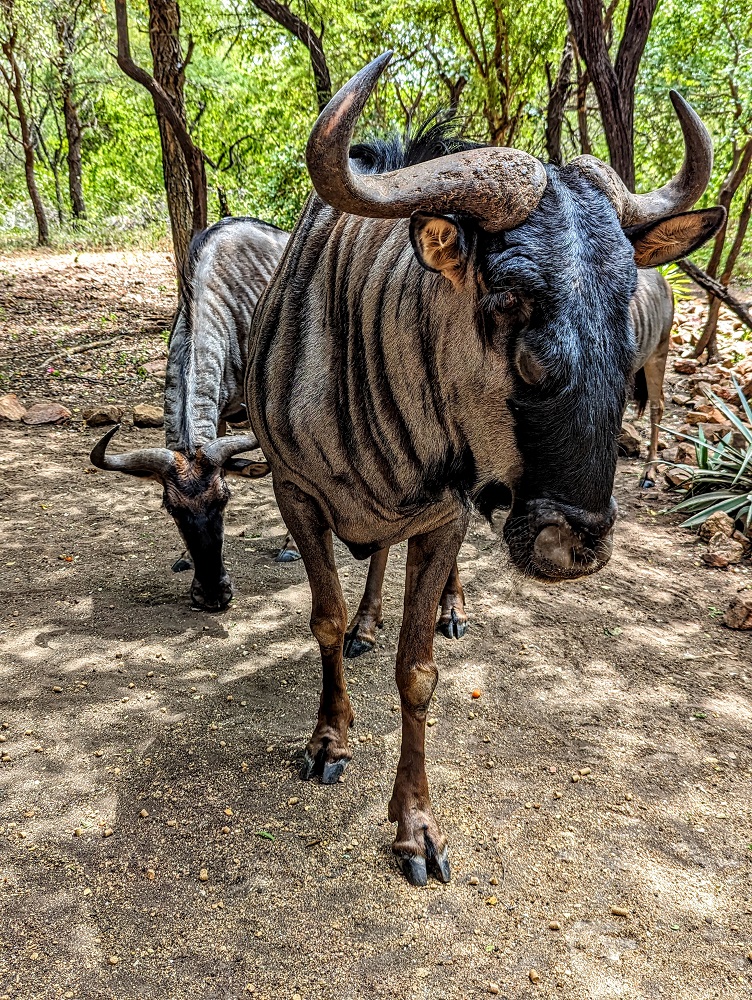
Sometimes they’d come to eat, while other times they’d lay down for an afternoon nap.
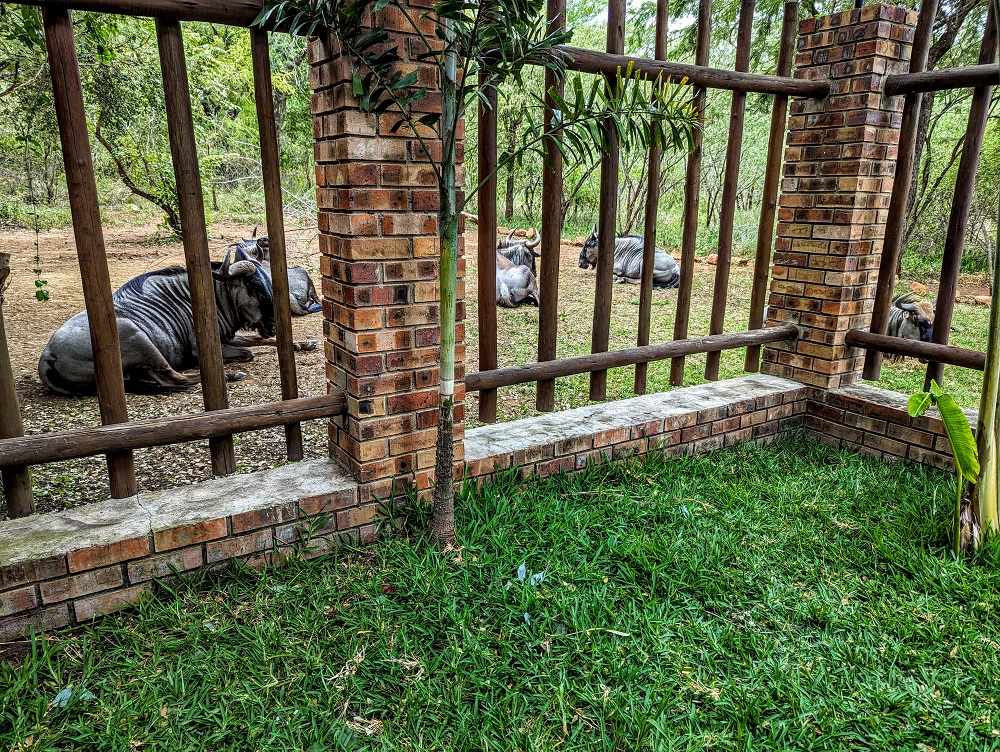
Monkeys
We didn’t see them very often which is probably not a bad thing seeing as they’re mischief-makers, but we did occasionally see monkeys while driving through Marloth Park.
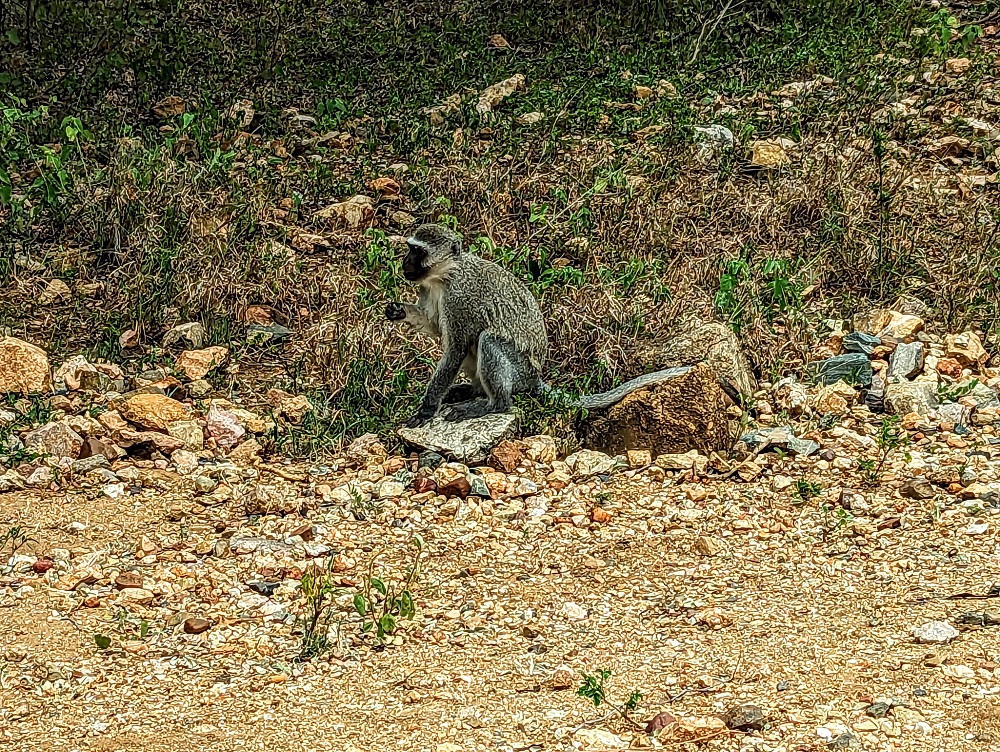
Scorpions
We’ll leave you with one that we didn’t want to come across accidentally, but which we did go searching for on our final night using special flashlights – scorpions. They usually stay burrowed in tree trunks and on our final night we found three like that. Thankfully we didn’t find any in the house during our stay!
The scorpions were much smaller than I’d been imagining. For some reason I’d pictured them being 3″-6″ long (apparently some are), but the ones we saw were barely 1″. I’m glad we never stepped on any by accident because apparently the smaller they are, the more venomous they are.
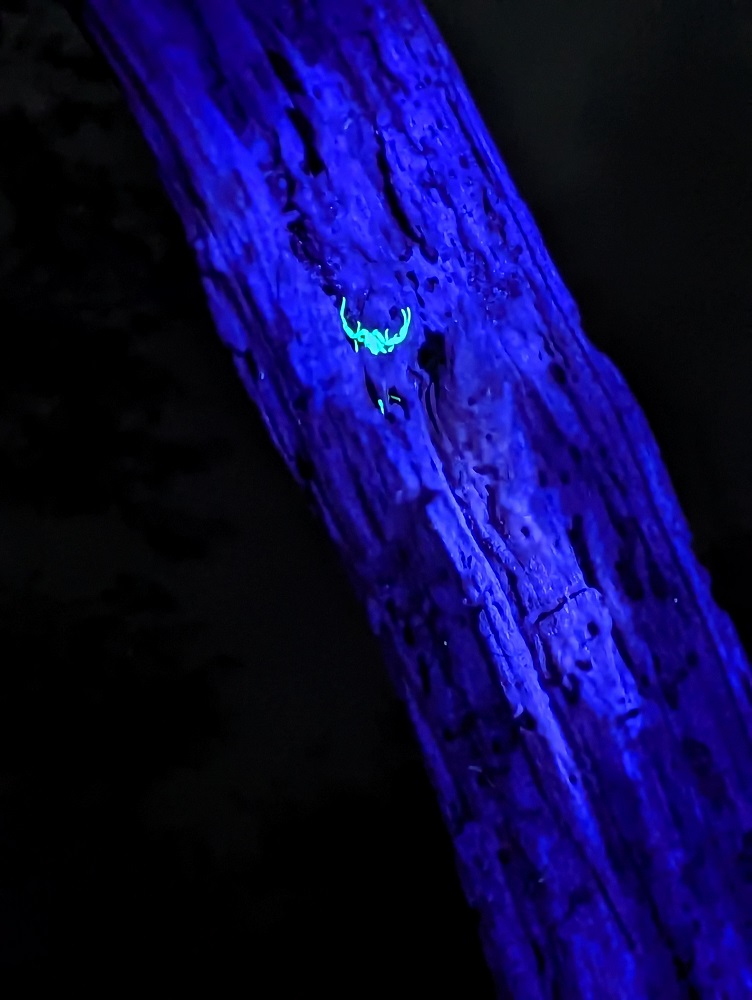
Final Thoughts
Shae and I loved staying in Marloth Park while visiting Kruger National Park. So much so that we’re talking seriously about moving there one day. Pets aren’t allowed in Marloth Park due to the presence of wild animals, so this would be a post-Truffles plan and we expect/hope for her to be around for another 10 years.
It’s a wonderful place with a lot of selling points. The house prices are very reasonable for what you get; a four bedroom, four bathroom home in good condition was being sold for ~$175,000. The cost of living in South Africa is cheaper than the US and UK too.
Ultimately though, the thing that most attracts us to Marloth Park is the animals. It was amazing being able to sit in someone’s backyard and see all the animals above. That’s not the only animals they get – they’ve had zebras, they’ve seen lion prints, etc. Not only that, but Marloth Park is only a short drive to Kruger National Park where you can see even more wildlife like elephants, rhinos, hippos and much more.
See All Posts From This International Trip
- Lions & Quokkas & Scorpions, Oh My: A Month In Australia, South Africa & More
- We Were Denied Boarding To Australia – Here’s Why
- Flight Review: Lufthansa Business Class – Dallas-Fort Worth (DFW) To Frankfurt (FRA)
- Flight Review: Eurowings Discover Business Class – Frankfurt (FRA) To Mauritius (MRU)
- Some Thoughts On Mauritius
- Hotel Review: Hilton Mauritius Resort & Spa
- Hotel Review: Le Méridien Ile Maurice (Mauritius)
- Restaurant Review: Sunset Filaos In Pointe Aux Piments, Mauritius
- 20 Fun & Interesting Things To Do In Mauritius (+ Many Bonus Ideas)
- Hotel Review: Holiday Inn Mauritius Mon Tresor
- Flight Review: Air Mauritius Economy Class – Mauritius (MRU) To Johannesburg (JNB)
- The Awesome Drive Between Johannesburg & Kruger National Park
- 50 Animal Photos From Kruger National Park In South Africa Taken With Our Phones
- Kruger National Park: 13 Tips For A Successful Self-Drive Safari
- Elephant Kisses – Meeting Tswale In South Africa
- Kruger National Park: 30 Photos Taken With Shae’s Nikon Camera
- Doing A Kruger Park Bush Braai With Royal Safaris
- Marloth Park: Like Living In The Best Zoo Ever
- Hotel Review: InterContinental Johannesburg O.R. Tambo Airport, South Africa
- Flight Review: Qatar Airways Business Class (Qsuites) – Johannesburg (JNB) To Doha (DOH) To Miami (MIA)
- Hotel Review: Hyatt Regency Oryx Doha, Qatar
How lovely. Since your friends leave so much food that attracts the wildlife, don’t any of the big cats use that opportunity to find easily located prey?
It is common in Marloth Park for many residents to feed them. There isn’t enough (wild) food to go around for the number of prey animals, especially during the dry season, so they don’t just hang out at her house but go from house to house. She did hear a mother lioness and her cubs nearby recently but they move throughout Marloth and can go through the fence back to Kruger.